|
Global Herbals & Nutraceuticals Products
全球草本和營養品項
Index / Table of Content
Summary By Fucntion
| Herbal Extracts |
Acai Berry Extract
https://en.wikipedia.org/wiki/Açaí_palm

The açaí palm (, Portuguese: [asaˈi] ( listen), from Nheengatu asai), Euterpe oleracea, is
a species of palm tree (Arecaceae)
cultivated for its fruit (açaí
berries, or simply açaí), hearts of palm (a
vegetable), leaves, and trunk wood. listen), from Nheengatu asai), Euterpe oleracea, is
a species of palm tree (Arecaceae)
cultivated for its fruit (açaí
berries, or simply açaí), hearts of palm (a
vegetable), leaves, and trunk wood.
The oil is suitable for cooking or as a salad dressing, but is mainly used in cosmetics as shampoos, soaps or skin moisturizers.
The oil compartments in açaí fruit contain polyphenols such as procyanidin oligomers and vanillic acid, syringic acid, p-hydroxybenzoic acid, protocatechuic
acid, and ferulic acid, which were shown to degrade substantially during storage or exposure to heat. Although these compounds are under study for potential health effects, there remains no substantial evidence that açaí polyphenols have any effect in humans. Açaí oil is green in color, has a bland aroma, and is high in oleic and palmitic fatty
acids.
. |
Allium Sativum (Garlic)
https://en.wikipedia.org/wiki/Garlic

Garlic (Allium sativum) is a species in the onion genus, Allium. Its close relatives include the onion, shallot,
leek, chive, and Chinese onion. It is native to Central Asia and northeastern Iran and has long been a common seasoning worldwide, with a history of several thousand years of human consumption and use.A 2016 meta-analysis of case-control and cohort
studies found a moderate
inverse association between garlic intake and some cancers of the upper digestive tract.Another
meta-analysis found decreased rates of stomach cancer associated
with garlic intake, but cited confounding factors as limitations for interpreting these studies. Further
meta-analyses found similar results on the incidence of stomach cancer by consuming allium vegetables
including garlic. A 2014
meta-analysis of observational epidemiological studies
found that garlic consumption was associated with a lower risk of stomach cancer in Korean people. |
Aloe Vera Extract
https://en.wikipedia.org/wiki/Aloe_vera

Aloe vera ( or )
is a succulent plant species of the genus Aloe. An evergreen perennial,
it originates from the Arabian Peninsula, but grows wild in tropical, semi-tropical, and arid climates around the world. It is cultivated for agricultural and medicinal uses.The species is also used for decorative purposes and grows successfully indoors as a potted plant.
It is found in many consumer products including beverages, skin lotion, cosmetics, ointments or in the form of gel for minor burns and sunburns. There is little clinical evidence for the effectiveness or safety of Aloe vera extract as a cosmetic or medicine.
|
Amla (Emblica Officinalis)
https://en.wikipedia.org/wiki/Phyllanthus_emblica
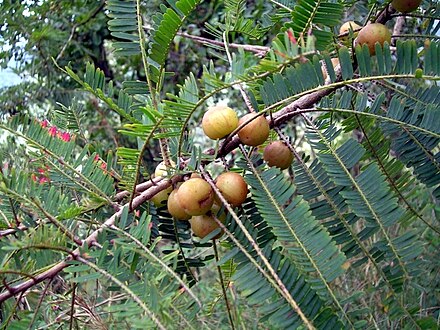
Phyllanthus emblica, also known as emblic, emblic myrobalan, myrobalan,[Indian gooseberry, Malacca tree, or amla from Sanskrit amalaki is a deciduous tree of the family
Phyllanthaceae. It has edible fruit, referred to by the same name. These fruits are reputed to contain high amounts of ascorbic acid (vitamin C), and have bitter taste that may derive from a high density of ellagitannins, such as emblicanin A (37%), emblicanin B (33%), punigluconin (12%), and pedunculagin (14%). Amla also contains
punicafolin and phyllanemblinin A, phyllanemblin other polyphenols, such as flavonoids, kaempferol, ellagic acid, and gallic acid |
Andrographis Paniculata
https://en.wikipedia.org/wiki/Andrographis_paniculata

Andrographis paniculata, commonly known as creat or green chiretta,[2] is an annual herbaceous plant in the family Acanthaceae, native to India and
Sri Lanka. Other common names for the plant include King of Bitter and hempedu bumi (Malay)It is widely cultivated in Southern and Southeastern Asia, where it has been traditionally been believed to be a treatment for bacterial infections and some diseases. Mostly the leaves and roots were used for such purposes. The whole plant is also used in some cases.A 2020 study found that Andrographis permitted chemosensitization of chemosensitive colorectal cancer cells. Two major pathways were altered by the Andrographis. One is the ferroptosis pathway,
the other is the β-catenin/Wnt-signaling pathway.
Andrographolide is the major constituent extracted from the leaves of the plant and is a bicyclic diterpenoid lactone. This bitter principle was isolated in pure form by Gorter (1911). Systematic studies on chemistry of A. paniculata have been carried out.
|
Apple Cider
https://en.wikipedia.org/wiki/Apple_cider
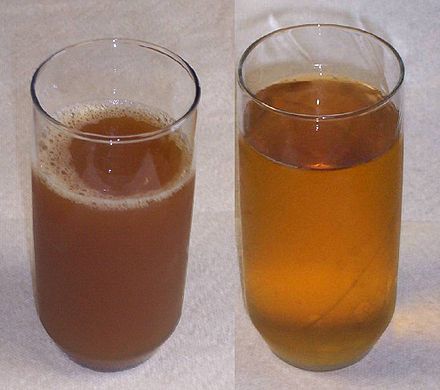
It is the liquid extracted from an apple and
all its components, that is then boiled to concentration. The liquid can be extracted from the apple itself, the apple core, the trimmings from apples, or apple culls. It is typically opaque due to fine apple particles in suspension and generally tangier than commercial filtered apple
juice, but this depends on the variety of apples used. Cider is typically pasteurized to
kill bacteria and extend its shelf life,
but untreated cider is common. In either form, apple cider is seasonally produced in autumn.
Many commercially produced ciders are pasteurized which extends their shelf life; the most common method used is pasteurization, but UV irradiation is also employed.
Pasteurization, which partially cooks the juice, results in some change of the sweetness, body and flavor of the cider; irradiation has less noticeable effects.
Impetus for Federal level regulation began with outbreaks of E. coli O157:H7 from unpasteurized apple cider and other illnesses caused by contaminated fruit juices in the late 1990s.
|
Ashwagandha
https://en.wikipedia.org/wiki/Withania_somnifera
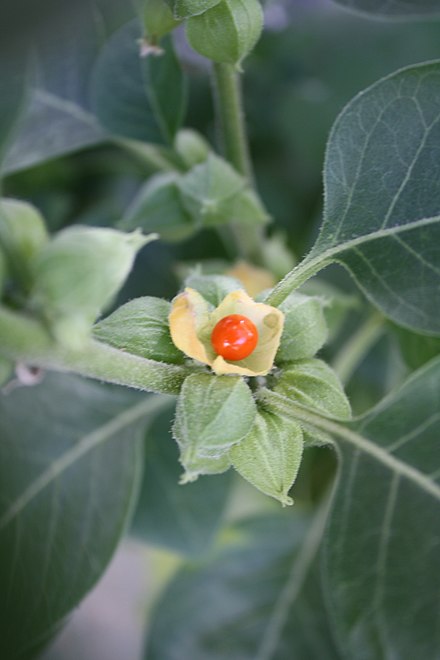
Withania somnifera, known commonly as ashwagandha, Indian
ginseng, poison
gooseberry, or winter
cherry, is
a plant in the Solanaceae or
nightshade family. Several other species in the genus Withania are
morphologically similar. Although
thought to be useful as a medicinal herb in Ayurveda,
trials supporting its clinical use are limited. However, many in vitro and animal experiments suggest effects on the immune, endocrine, and CNS systems, as well as in the pathogenesis of cancer and inflammatory conditions.The main phytochemical constituents are withanolides –
which are triterpene lactones –
withanolides, withaferin A, alkaloids, steroidal lactones, tropine,
and cuscohygrine. Some 40 withanolides, 12 alkaloids, and numerous sitoindosides have been isolated. Withanolides are structurally similar to the ginsenosides of Panax
ginseng, leag to a common name for W. somnifera, "Indian ginseng". |
Asparagus Racemosus
https://en.wikipedia.org/wiki/Asparagus_racemosus

Asparagus racemosus (satavar, shatavari,
or shatamull, shatawari)
is a species of asparagus common throughout India and
the Himalayas.
Asparagamine A, a polycyclic alkaloid was isolated from the dried roots and subsequently synthesized to allow for the construction of analogs.
Steroidal saponins, shatavaroside A, shatavaroside B, filiasparoside
C, shatavarins, immunoside, and schidigerasaponin D5 (or asparanin A) were isolated from the roots of Asparagus racemosus.
Also known is the isoflavone 8-methoxy-5,6,4'-trihydroxyisoflavone 7-O-β-D-glucopyranoside.
|
Azadirachta Indica
https://en.wikipedia.org/wiki/Azadirachta_indica
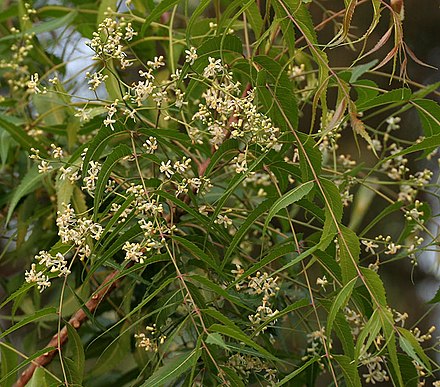
Azadirachta indica, commonly known as neem, nimtree or Indian
lilac, is
a tree in the mahogany family Meliaceae.
It is one of two species in the genus Azadirachta, and is native to the Indian
subcontinent.
Ayurveda was the first to bring the anthelmintic, antifungal, antibacterial, and antiviral constituents
of the neem tree to the attention of natural products chemists. The process of extracting neem oil involves extracting the water-insoluble components with ether, petrol ether, ethyl
acetate, and dilute alcohol. The provisional naming was nimbin (sulphur-free crystalline product with melting point at 205 °C, empirical composition
C7H10O2), nimbinin (with similar principle, melting at 192 °C), and nimbidin (cream-coloured containing amorphous sulphur, melting at 90–100 °C). Siddiqui identified nimbidin as the main active antibacterial ingredient, and the highest yielding bitter component in the neem oil. These
compounds are stable and found in substantial quantities in the neem. They also serve as natural insecticides.
Neem-coated urea is being used an alternate to plain urea fertilizer in India. It reduces pollution, improves fertilizer's efficacy and soil health.
|
Bacopa Monnieri
https://en.wikipedia.org/wiki/Bacopa_monnieri

Bacopa monnieri is
a perennial, creeping herb native
to the wetlands of southern and Eastern India, Australia, Europe, Africa, Asia, and North and South America.It is known by the common names water hyssop,waterhyssop, brahmi,thyme-leafed
gratiola, herb
of grace,and Indian pennywort.The
best characterized phytochemicals in Bacopa monnieri are dammarane-type triterpenoid saponins known
as bacosides, with jujubogenin or pseudo-jujubogenin moieties as aglycone units. Bacosides
comprise a family of 12 known analogs. Other saponins called bacopasides I–XII
were identified. The alkaloids brahmine, nicotine,
and herpestine have been catalogued, along with D-mannitol, apigenin,
hersaponin, monnierasides I–III, cucurbitacin and plantainoside B. |
Boswellia Serrata
https://en.wikipedia.org/wiki/Boswellia_serrata

Boswellia serrata is
a plant that produces Indian frankincense.
It is also known as Indian oli-banum, Salai guggul, and Sallaki in Sanskrit.
Boswellia serrata contains various derivatives of boswellic acid including β-boswellic acid, acetyl-β-boswellic acid, 11-keto-β-boswellic acid and acetyl-11-keto-β-boswellic acid.
Extracts of Boswellia serrata have been clinically studied for osteoarthritis and joint function, with the research showing trends of benefit (slight improvement) in pain and function. It has been used in Indian traditional medicine for diabetes.
|
Calcium Sennoside 10% To 60%
https://en.wikipedia.org/wiki/Senna_glycoside

Senna glycoside, also known as sennoside or senna,
is a medication used to treat constipation and
empty the large intestine before
surgery. The
medication is taken by mouth or via the rectum. It
typically begins working in minutes when given by rectum and within twelve hours when given by mouth. It
is a weaker laxative than bisacodyl or castor
oil. |
Cranberry Extract
https://en.wikipedia.org/wiki/Cranberry

Cranberries are
a group of evergreen dwarf
shrubs or trailing vines in
the subgenus Oxycoccus of
the genus Vaccinium. In
2017, the United States, Canada, and Chile accounted for 98% of the world production of cranberries. Most cranberries are processed into products such as juice, sauce, jam, and sweetened dried
cranberries, with the remainder sold fresh to consumers. |
Caralluma Fimbriata Extract
https://en.wikipedia.org/wiki/Caralluma_adscendens

Caralluma adscendens is
a succulent plant in
the family Apocynaceae. Its distribution ranges from India and Sri
Lanka through the Arabian peninsula
to North Africa and
the Sahel.The key phytochemical
constituents of the herb are pregnane glycosides, flavone glycosides, megastigmane glycosides,
and saponins.
The key phytochemical constituents of the herb are pregnane glycosides, flavone glycosides, megastigmane glycosides,
and saponins. |
Cinnamon Bark Extract
https://en.wikipedia.org/wiki/Cinnamon

Cinnamon is
a spice obtained
from the inner bark of several tree species from the genus Cinnamomum. Cinnamon is used mainly as an aromatic condiment and
flavouring additive in a wide variety of cuisines, sweet and savoury dishes, breakfast
cereals, snackfoods, tea and traditional
foods. The aroma and flavour of cinnamon derive from its essential oil and
principal component, cinnamaldehyde, as well as numerous other constituents including eugenol.Reviews
of clinical trials reported lowering of fasting plasma glucose and
inconsistent effects on hemoglobin A1C (HbA1c, an indicator of chronically elevated plasma glucose). Four of the reviews reported a decrease in fasting plasma glucose, only two reported lower HbA1c, and one reported no change to either measure. |
Coleus Forskohlii
https://en.wikipedia.org/wiki/Coleus_barbatus

Coleus barbatus, also known by the synonyms Plectranthus
barbatus and
incorrectly Coleus forskalaei (and
other spellings of this epithet), is a tropical perennial plant related to the typical coleus species.
It produces forskolin, an extract useful
for pharmaceutical preparations
and research in cell biology.
Herbal teas made from Coleus barbatus contain rosmarinic acid and also flavonoid glucuronides and diterpenoids The
chemical constituents of Plectranthus barbatus showed activities in vitro, such as acetylcholinesterase inhibition.
Forskolin, which derives its name from the incorrect binomial name Coleus forskohlii, is a constituent of Plectranthus barbatus.
|
Commiphora Mukul
https://en.wikipedia.org/wiki/Commiphora_wightii
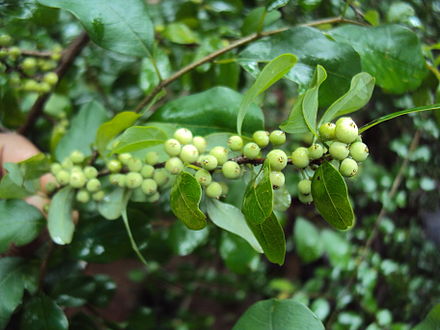
Commiphora wightii, with common
names Indian bdellium-tree, gugal] guggul, gugul, or Mukul
myrrh tree, is a flowering plant in
the family Burseraceae, which produces a fragrant resin called gugal, guggul or gugul, that is used in incense and
vedic medicine (or ayurveda).Over a
hundred metabolites of
various chemical compositions were reported from the leaves, stem, latex, root and fruit samples. High concentrations of quinic acid and myo-inositol were
found in fruits and leaves. |
Curcumin 95%
https://en.wikipedia.org/wiki/Curcumin

Curcumin is
a bright yellow chemical produced by Curcuma longa plants.
It is the principal curcuminoid of turmeric (Curcuma
longa), a member of the ginger family, Zingiberaceae.
It is sold as an herbal supplement, cosmetics ingredient,
food flavoring, and food coloring.
Curcumin incorporates several functional groups whose structure was first identified in 1910. The aromatic ring systems, which are phenols, are connected by two α,β-unsaturated carbonyl groups. The diketones form stable enols and are readily deprotonated to form enolates; the
α,β-unsaturated carbonyl group is a good Michael acceptor and undergoes nucleophilic addition.
Curcumin is used as a complexometric indicator for boron. It reacts with boric acid to form a red-colored compound, rosocyanine.
|
Epimedium-Horny Goat Weed (Leaf)
https://en.wikipedia.org/wiki/Epimedium

Epimedium, also known as barrenwort, bishop's hat, fairy wings, horny goat weed, is a genus of flowering plants in the family Berberidaceae.
The majority of the species are endemic to China, with smaller numbers elsewhere in Asia, and a few in the Mediterranean region.
Epimedium species are deciduous or evergreen hardy perennials. The majority have four-parted "spider-like" flowers in spring.
The species used as a dietary supplement is Epimedium grandiflorum. It contains icariin, which is a weak PDE5 inhibitor in vitro. Its clinical effects are unknown.
Epimedium wushanense contains
a number of flavanoids. 37 compounds were characterized from the underground and aerial parts of the plant. Among them, 28 compounds were prenylflavonoids.
The predominant flavonoid, epimedin C,
ranged from 1.4 to 5.1% in aerial parts and 1.0 to 2.8% in underground parts.
|
Fenugreek Extract
https://en.wikipedia.org/wiki/Fenugreek

Fenugreek (; Trigonella
foenum-graecum) is an annual plant in the family Fabaceae, with leaves consisting of three small obovate
to oblong leaflets. It is
cultivated worldwide as a semiarid crop. Its seeds and leaves are common ingredients in dishes from the Indian subcontinent. Also used in traditional
medicine, fenugreek can increase the risk for serious medical side effects,
though its culinary use (in smaller quantities) is usually believed to be safe. Fenugreek
is not approved or recommended for clinical use by any governmental health agency. |
Garcinia Cambogia
https://en.wikipedia.org/wiki/Garcinia_gummi-gutta

Garcinia gummi-gutta is
a tropical species of Garcinia native
to Indonesia. Although
few high-quality studies have been done to define the composition of the fruit, its phytochemical content includes hydroxycitric
acid which is extractable and developed as a dietary
supplement. Other compounds identified in the fruit include the polyphenols, luteolin,
and kaempferol. |
Ginger Extract
https://en.wikipedia.org/wiki/Ginger
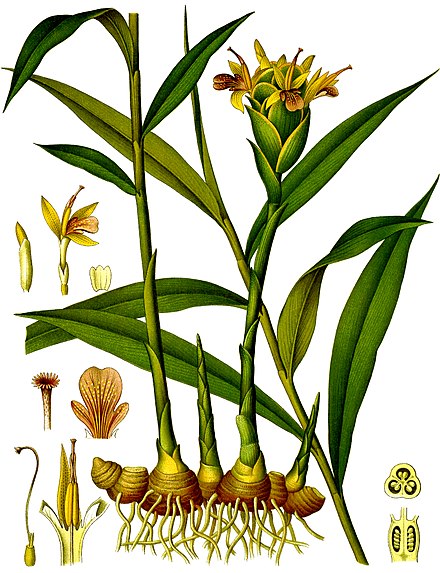
inger (Zingiber
officinale) is a flowering plant whose rhizome, ginger
root or ginger, is widely
used as a spice and
a folk medicine.
The characteristic fragrance and flavor of ginger result from volatile oils that compose 1-3% of the weight of fresh ginger, primarily consisting of zingerone, shogaols, and gingerols with
[6]-gingerol (1-[4'-hydroxy-3'-methoxyphenyl]-5-hydroxy-3-decanone) as the major pungent compound.[Zingerone is produced from gingerols during drying, having lower pungency and a spicy-sweet aroma. Shogaols are more pungent and have higher antioxidant activity but not found in raw ginger, but is formed from gingerols during heating, storage or via acidity.
Fresh ginger also contains an enzyme zingibain which is a cysteine protease and has similar properties to rennet.
|
Ginkgo Biloba 24, 24/6
https://en.wikipedia.org/wiki/Ginkgo_biloba

|
Ginseng Extract
https://en.wikipedia.org/wiki/Ginseng

Ginseng ()
is the root of plants in the genus Panax, such as Korean
ginseng (P.
ginseng), South China ginseng (P.
notoginseng), and American ginseng (P.
quinquefolius), typically characterized by the presence of ginsenosides and gintonin.Ginseng
may be included in energy drinks or herbal
teas in small amounts or sold as a dietary supplement. |
Glycyrrhiza (Licorice Extract)
https://en.wikipedia.org/wiki/Liquorice

Liquorice (British
English) or licorice (American
English) ( LIK-ər-is(h)) is
the common name of Glycyrrhiza glabra, a flowering plant of
the bean family Fabaceae, from the
root of which a sweet, aromatic flavouring can be extracted.
Liquorice is used as a flavouring in candies and tobacco, particularly in some European and West Asian countries.
Liquorice extracts have been used in herbalism and traditional medicine.
The scent of liquorice root comes from a complex and variable combination of compounds, of which anethole is up to 3% of total volatiles. Much of the sweetness in liquorice comes from glycyrrhizin, which has a sweet taste, 30–50 times the sweetness of sugar. The sweetness is very different from sugar, being less instant, tart, and lasting longer.
The isoflavene glabrene and the isoflavane glabridin, found in the roots of liquorice, are phytoestrogens.
|
Grape Seed Extract
https://en.wikipedia.org/wiki/Grape#Seed_constituents

A grape is a fruit, botanically a berry, of the deciduous woody vines of the flowering plant genus Vitis.
Grapes can be eaten fresh as table grapes or they can be used for making wine, jam, grape juice, jelly, grape
seed extract, raisins, vinegar, and grape seed oil. Grapes are a non-climacteric type of fruit, generally occurring in clusters.
Winemaking from red and white grape flesh and skins produces substantial quantities of organic residues, collectively called pomace (also
"marc"), which includes crushed skins, seeds, stems, and leaves generally used as compost. Grape
pomace – some 10-30% of the total mass of grapes crushed – contains various phytochemicals, such as unfermented sugars, alcohol, polyphenols, tannins, anthocyanins,
and numerous other compounds, some of which are harvested and extracted for
commercial applications (a process sometimes called "valorization" of the pomace). |
Griffonia (5 Htp)
https://en.wikipedia.org/wiki/5-Hydroxytryptophan

5-Hydroxytryptophan (5-HTP),
also known as oxitriptan, is a naturally occurring amino
acid and chemical precursor as
well as a metabolic intermediate in
the biosynthesis of
the neurotransmitter serotonin.
Though 5-HTP is found in food only in insignificant quantities, it is a chemical involved intermediately in the metabolism of tryptophan, an amino acid found in all unfractionated foods, with lower total amino acid content correlating with increased tryptophan absorption.
The seeds of the Griffonia simplicifolia, a climbing shrub native to West Africa and Central Africa, are used as an herbal supplement for their 5-hydroxytryptophan (5-HTP) content
|
Green Coffee Extract
https://en.wikipedia.org/wiki/Green_coffee_extract

Green coffee extract is
an extract of unroasted, green coffee beans. It is used in the Swiss
Water Process for
decaffeinating coffee. It has also been used as a weight-loss supplement and as an ingredient in other weight-loss products but its efficacy and mechanism of action have been controversial.Nonvolatile and volatile compounds in green coffee beans, such as caffeine, deter many
insects and animals from eating them. Further, both nonvolatile and volatile compounds contribute to the flavor of the coffee bean when it is roasted. Nonvolatile nitrogenous compounds
(including alkaloids, trigonelline,
proteins, and free amino acids) and carbohydrates are
of major importance in producing the full aroma of roasted coffee and for its biological action. Since the mid 2000s, green coffee extract has been sold as a nutritional supplement and has been clinically studied for its chlorogenic
acid content and for its lipolytic and weight-loss properties. |
Green Tea Extract
https://en.wikipedia.org/wiki/Green_tea#Extracts
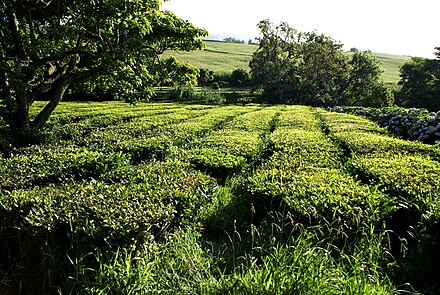
Polyphenols found
in green tea include epigallocatechin gallate (EGCG), epicatechin
gallate, epicatechins and flavanols, which
are under laboratory research for their potential effects in vivo. Other
components include three kinds of flavonoids, known as kaempferol, quercetin,
and myricetin. Although
the mean content of flavonoids and catechins in
a cup of green tea is higher than that in the same volume of other food and drink items that are traditionally considered to promote health, flavonoids
and catechins have no proven biological effect in humans. |
Guggul
https://en.wikipedia.org/wiki/Commiphora_wightii

Commiphora wightii, with common
names Indian bdellium-tree, gugal, guggul, gugul, or Mukul
myrrh tree, is a flowering plant in
the family Burseraceae, which produces a fragrant resin called gugal, guggul or gugul, that is used in incense and
vedic medicine (or ayurveda). Over
a hundred metabolites of various chemical compositions were reported from the leaves, stem, latex, root and fruit samples. High concentrations of quinic
acid and myo-inositol were found in fruits and leaves. |
Gymnema Sylvestre
https://en.wikipedia.org/wiki/Gymnema_sylvestre

Gymnema sylvestre is a perennial woody vine native to tropical Asia, China, the Arabian Peninsula, Africa, and Australia. It has been used in Ayurvedic medicine. Common names include gymnema, Australian cowplant, and Periploca of the woods, and the Hindi term gurmar, which means "sugar destroyer".
The leaves and extracts contain gymnemic acids, the major bioactive constituents that interact with taste receptors on the tongue to temporarily suppress the taste of sweetness.
|
Holi Basil Extract
https://en.wikipedia.org/wiki/Ocimum_tenuiflorum

Ocimum tenuiflorum (synonym Ocimum
sanctum), commonly known as holy basil or tulsi,
is an aromatic perennial plant
in the family Lamiaceae. It is native to the Indian
subcontinent and widespread
as a cultivated plant throughout the Southeast Asian tropics.
Some of the phytochemical constituents of tulsi are oleanolic acid, ursolic acid, rosmarinic acid, eugenol, carvacrol, linalool,
and β-caryophyllene (about 8%). Tulsi essential oil consists mostly of eugenol (~70%) β-elemene (~11.0%), β-caryophyllene (~8%), and germacrene (~2%),
with the balance being made up of various trace compounds, mostly terpenes.
|
Ivy Leaf Extract
https://en.wikipedia.org/wiki/Glechoma_hederacea
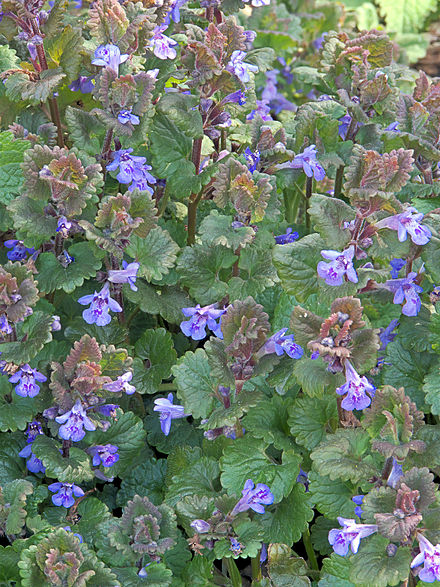
Glechoma hederacea (syn. Nepeta glechoma Benth., Nepeta hederacea (L.) Trevir.) is an aromatic, perennial, evergreen creeper
of the mint family Lamiaceae. It is commonly known as ground-ivy, gill-over-the-ground, creeping charlie, alehoof, tunhoof, catsfoot, field balm, and run-away-robin. It is also sometimes known as creeping jenny, but that name more commonly refers to Lysimachia
nummularia. It is used as a salad green in many countries. European settlers carried it around the world, and it has become a well-established introduced and naturalized plant in a wide variety of localities.
It is considered an aggressive invasive weed of woodlands and lawns in some parts of North America. In the absence of any biological control research conducted by the USDA herbicides are relied upon, despite their drawbacks, particularly for woodland ecosystems. The plant's extensive root system makes it difficult to eradicate by hand-pulling.
|
Korean Ginseng
https://en.wikipedia.org/wiki/Panax_ginseng
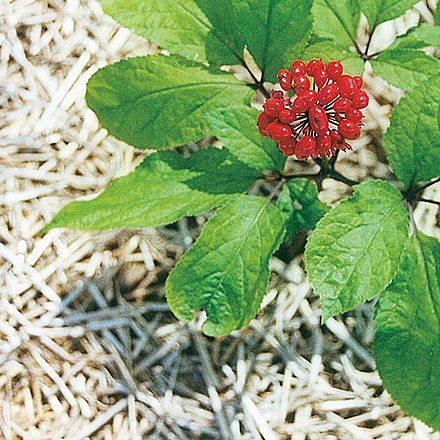
Panax ginseng, the ginseng, also
known as Asian ginseng, Chinese
ginseng, or Korean
ginseng, is
a species of plant whose root is the original source of ginseng. It is a perennial plant that grows in the mountains of East
Asia. |
Liquorice Extract
https://en.wikipedia.org/wiki/Liquorice

Liquorice (British
English) or licorice (American
English) ( LIK-ər-is(h)) is
the common name of Glycyrrhiza glabra, a flowering plant of
the bean family Fabaceae, from the
root of which a sweet, aromatic flavouring can be extracted.
Liquorice is used as a flavouring in candies and tobacco, particularly in some European and West Asian countries.
Liquorice extracts have been used in herbalism and traditional medicine.
The scent of liquorice root comes from a complex and variable combination of compounds, of which anethole is up to 3% of total volatiles. Much of the sweetness in liquorice comes from glycyrrhizin, which has a sweet taste, 30–50 times the sweetness of sugar. The sweetness is very different from sugar, being less instant, tart, and lasting longer.
The isoflavene glabrene and the isoflavane glabridin, found in the roots of liquorice, are phytoestrogens.
|
Menthol
https://en.wikipedia.org/wiki/Menthol

Menthol is an organic compound made synthetically or obtained from the oils of corn mint, peppermint, or other mints.
It is a waxy, crystalline substance, clear or white in color, which is solid at room temperature and melts slightly above.
The main form of menthol occurring in nature is (−)-menthol, which is assigned the (1R,2S,5R) configuration. Menthol has local anesthetic and counterirritant qualities, and it is widely used to relieve minor throat
irritation. Menthol also acts as a weak kappa opioid receptor agonist.
In 2017, it was the 193rd most commonly prescribed medication in the United States, with more than two million prescriptions.
|
Methoxsalen
https://en.wikipedia.org/wiki/Methoxsalen

Methoxsalen (also
called xanthotoxin), sold under the brand name Oxsoralen among
others, is a drug used
to treat psoriasis, eczema, vitiligo,
and some cutaneous lymphomas in
conjunction with exposing the skin to UVA light from lamps or sunlight. Methoxsalen modifies the way skin cells receive the UVA radiation,
allegedly clearing up the disease. In 1970, Nielsen extracted 8-methoxypsoralen from four species of the genus Heracleum in
the carrot family Apiaceae, including Heracleum
mantegazzianum and Heracleum
sphondylium. An additional 32 species of the genus Heracleum were
found to contain 5-methoxypsoralen (bergapten) or other furanocoumarins. |
Moringa Oleifera
https://en.wikipedia.org/wiki/Moringa_oleifera

Moringa oleifera is
a fast-growing, drought-resistant tree of the family Moringaceae, native to the Indian
subcontinent.It is widely cultivated for its young seed
pods and leaves used as vegetables and
for traditional herbal
medicine. It is also used for water purification. |
Mucuna Pruriens
https://en.wikipedia.org/wiki/Mucuna_pruriens

Mucuna pruriens is
a tropical legume native
to Africa and tropical Asia and widely naturalized and cultivated. Its
English common names include monkey
tamarind, velvet
bean, Bengal
velvet bean, Florida
velvet bean, Mauritius
velvet bean, Yokohama
velvet bean, cowage, cowitch, lacuna
bean, and Lyon bean. The
plant is notorious for the extreme itchiness it produces on contact, particularly
with the young foliage and the seed pods. It has agricultural and horticultural value and is used in herbalism. |
Nigella Sativa Extract
https://en.wikipedia.org/wiki/Nigella_sativa
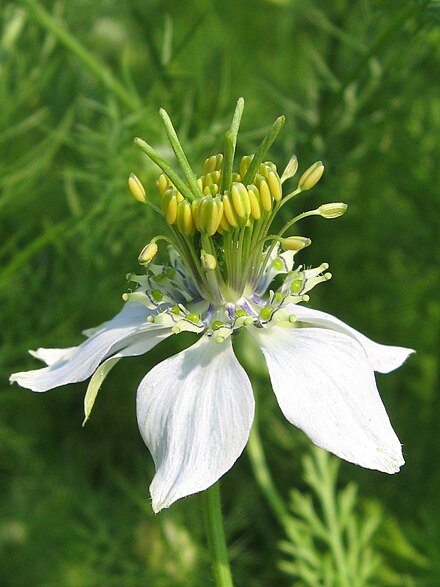
In the United States, the Food and Drug Administration classifies Nigella
sativa L. (black cumin,
black caraway) as Generally Recognized as Safe (GRAS)
for use as a spice, natural seasoning, or flavoring.Oils are 32% to 40% of the total composition of N. sativa seeds. N.
sativa oil contains linoleic acid, oleic
acid, palmitic acid, and trans-anethole,
and other minor constituents, such as nigellicine, nigellidine, nigellimine, and nigellimine N-oxide. Aromatics include thymoquinone,
dihydrothymoquinone, p-cymene, carvacrol, α-thujene, thymol, α-pinene, β-pinene and trans-anethole. Protein and
various alkaloids are present in the seeds. |
Omega 3
https://en.wikipedia.org/wiki/Omega-3_fatty_acid
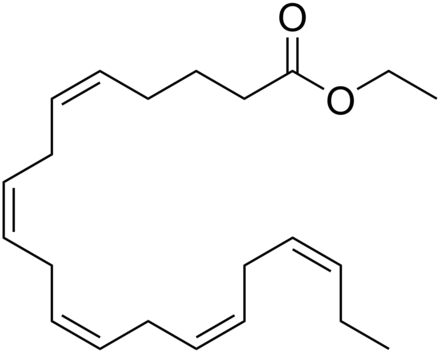
Omega−3 fatty acids, also called Omega-3
oils, ω−3
fatty acids or n−3
fatty acids, are polyunsaturated
fatty acids (PUFAs)
characterized by the presence of a double bond three atoms away from the terminal methyl group in their chemical structure. They are widely distributed in nature, being important constituents of animal lipid metabolism,
and they play an important role in the human diet and in human physiology. The
three types of omega−3 fatty acids involved in human physiology are α-linolenic acid (ALA), found in plant oils, and eicosapentaenoic
acid (EPA) and docosahexaenoic
acid (DHA), both commonly
found in marine oils. |
Papaya Leaf Extract
https://en.wikipedia.org/wiki/Papaya

The papaya (, )
(from Carib via
Spanish), papaw, ()
or pawpaw ( is
the plant Carica
papaya, one of the 22 accepted species in the genus Carica of
the family Caricaceae.
Papaya skin, pulp, and seeds contain a variety of phytochemicals, including carotenoids and polyphenols,as well as benzyl isothiocyanates and benzyl glucosinates, with skin and pulp levels that increase during ripening. Papaya seeds also contain the cyanogenic substance prunasin.
In traditional medicine, papaya leaves have been used as a treatment for malaria, an abortifacient,
a purgative, or smoked to relieve asthma.
|
Psyllium Husk
https://en.wikipedia.org/wiki/Psyllium
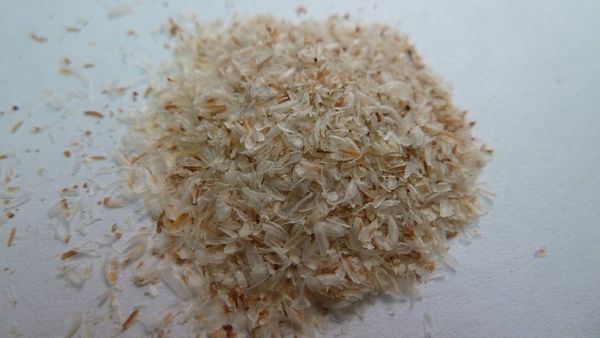
Psyllium ,
or ispaghula (isabgol) ,
is the common name used for several members of the plant genus Plantago whose
seeds are used commercially for the production of mucilage.
Psyllium is mainly used as a dietary fiber to relieve symptoms of both constipation and
mild diarrhea,
and occasionally as a food thickener. It
is commonly used as a food ingredient in
manufactured breakfast cereals which
may contribute to a healthy lifestyle by improving blood cholesterol levels
and gastrointestinal function.Psyllium
is produced mainly for its mucilage content.
The term mucilage describes
a group of clear, colorless, gelling agents derived from plants. The mucilage obtained from psyllium comes from the seed coat. Mucilage is obtained by mechanical milling (i.e. grinding) of the outer layer of the seed. Mucilage yield amounts to about 25% (by weight) of the total seed yield. Plantago-seed mucilage is often referred to as husk,
or psyllium husk. The milled seed mucilage is a white fibrous material that is hydrophilic,
meaning that its molecular structure causes it to attract and bind to water. Upon absorbing water, the clear, colorless, mucilaginous gel that forms increases in volume by tenfold or more. |
Podophyllum Resin
https://en.wikipedia.org/wiki/Podophyllum_resin

Podophyllum resin, also known as podophyllum or podophyllin,
is a resin made
from the roots of
the American mandrake. It
is used as a medication to treat genital warts and plantar
warts, including in people with HIV/AIDS.It
is not recommended in HPV infections without
external warts. Application by a healthcare provider to the skin is recommended.
Podophyllin resin has been used to treat warts since at least 1820. It is on the World
Health Organization's List of Essential Medicines, the safest and most effective medicines needed in a health system. |
Pomegranate Extract
https://en.wikipedia.org/wiki/Pomegranate
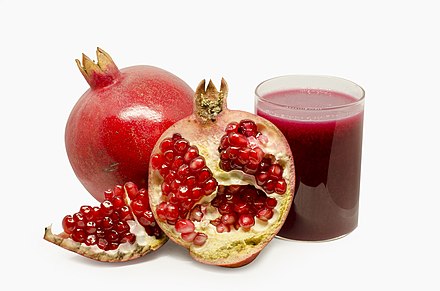
The pomegranate (Punica
granatum) is a fruit-bearing deciduous shrub in
the family Lythraceae, subfamily
Punicoideae, that grows between 5 and 10 m (16 and 33 ft) tall
Pomegranate peel contains high amount of polyphenols, condensed tannins, catechins, and prodelphinidins.The higher phenolic content of the peel yields extracts for use in dietary
supplements and food preservatives.
Pomegranate seed oil contains punicic acid (65%), palmitic acid (5%), stearic acid (2%), oleic acid (6%), and linoleic
acid (7%)
|
Red Clover Extract
https://en.wikipedia.org/wiki/Trifolium_pratense
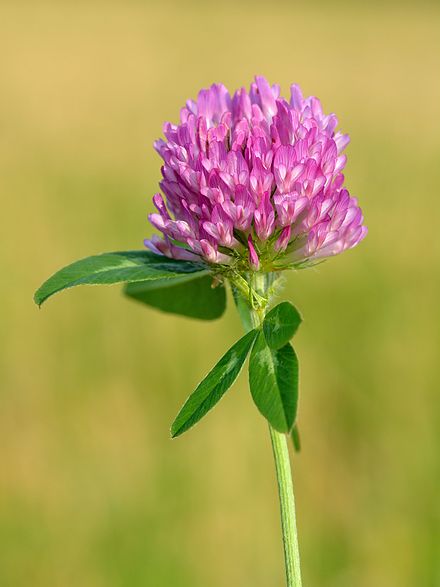
Trifolium pratense, the red
clover, is
a herbaceous species of flowering
plant in the bean family Fabaceae,
native to Europe, Western
Asia, and northwest Africa, but planted and
naturalised in many other regions.
It is widely grown as a fodder crop, valued for its nitrogen fixation, which increases soil fertility. For these reasons, it is used as a green manure crop. Several cultivar groups have been selected for agricultural use, mostly derived from T. pratense var. sativum.
It has become naturalised in many temperate areas, including the Americas and Australasia as an escape from cultivation.
Due to its beauty, it is used as an ornamental plant.
Red clover's flowers and leaves are edible, and can be added as garnishes to any dish. They can be ground into a flour.
|
Reserpine
https://en.wikipedia.org/wiki/Reserpine

Reserpine is
a drug that is used for the treatment of high blood pressure, usually in combination with a thiazide diuretic
or vasodilator.
Reserpine irreversibly blocks the H+-coupled vesicular monoamine transporters, VMAT1 and VMAT2. VMAT1 is mostly expressed in neuroendocrine
cells. VMAT2 is mostly expressed in neurons. Thus, it is the blockade of neuronal VMAT2 by reserpine that inhibits uptake and reduces stores of the monoamine neurotransmitters norepinephrine, dopamine, serotonin and histamine in
the synaptic vesicles of neurons. VMAT2 normally transports free intracellular norepinephrine, serotonin, and dopamine in the presynaptic nerve terminal into presynaptic vesicles for subsequent release into the synaptic cleft ("exocytosis"). Unprotected neurotransmitters are metabolized by MAO (as well as by COMT),
attached to the outer membrane of the mitochondria in the cytosol of the axon terminals, and consequently never excite the post-synaptic cell. Thus, reserpine increases removal of monoamine neurotransmitters from neurons, decreasing the size of the neurotransmitter pools, and thereby decreasing the amplitude of neurotransmitter release.
It may take the body days to weeks to replenish the depleted VMATs, so reserpine's effects are long-lasting.Reserpine inhibits formation of biofilms by Staphylococcus aureus and
inhibits the metabolic activity of bacteria present in biofilms.
|
Saw Palmetto
ttps://en.wikipedia.org/wiki/Serenoa
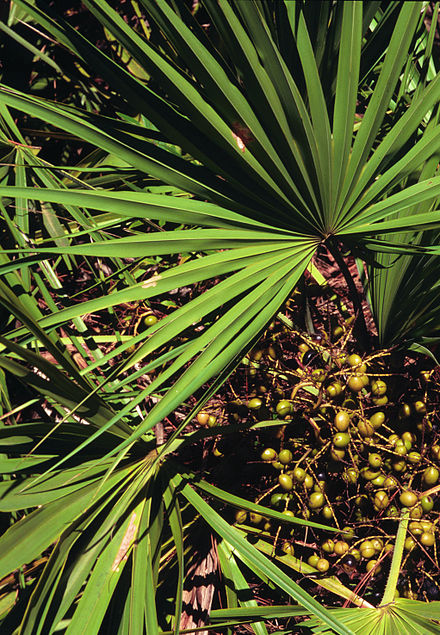
Serenoa repens, commonly known as saw
palmetto, is the sole species
currently classified in the genus Serenoa.
Benign prostatic hyperplasia (BPH) — also called prostate gland enlargement — is a common condition in elderly men, with an enlarged prostate causing lower urinary tract symptoms, such as inhibiting urine flow from the bladder. BPH may be associated with other urinary tract, bladder or kidney
disorders.
Saw palmetto extract has been studied as a possible treatment for people with prostate cancer and for men with lower urinary tract symptoms associated with BPH.
|
Sesame Seed Extract
https://en.wikipedia.org/wiki/Sesame
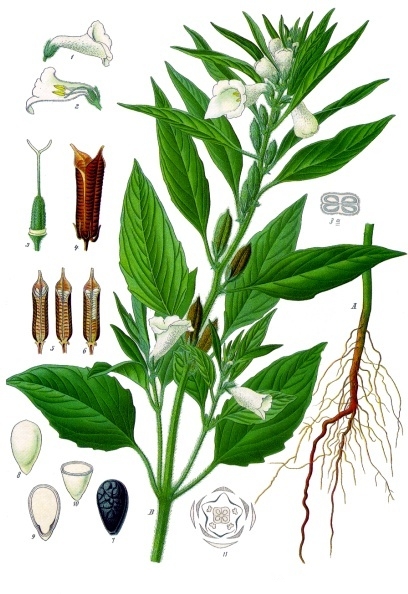
Sesame ( or ; Sesamum
indicum) is a flowering plant in
the genus Sesamum, also called benne.[2] Numerous
wild relatives occur in Africa and a smaller number in India. It is widely naturalized in
tropical regions around the world and is cultivated for its edible seeds, which grow in pods. World production in 2016 was 6.1 million tonnes, with Tanzania, Myanmar, India,
and Sudan as
the largest producers.
A meta-analysis showed that sesame consumption produced small reductions in both systolic and diastolic blood pressure. Sesame oil studies reported a
reduction of oxidative stress markers and lipid peroxidation.
Sesame seeds contain the lignans sesamolin, sesamin, pinoresinol, and lariciresinol.
|
Siberian Ginseng Extract
https://en.wikipedia.org/wiki/Eleutherococcus_senticosus
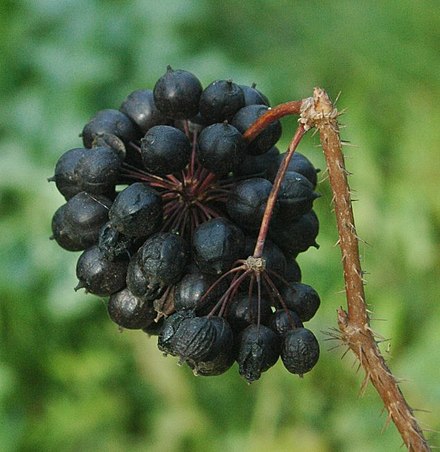
Eleutherococcus senticosus is
a species of small, woody shrub in
the family Araliaceae native
to Northeastern Asia.Root extracts of E.
senticosus are sold as a dietary supplement or cosmetic,
usually under the name Siberian ginseng.
Roots of E. senticosus are cylindrical, up to 0.5 centimetres (0.20 in) in diameter, straight or branched, dark brown, and have a smooth surface with bark fixed closely to the xylem. The derived extract from the roots has been characterized for its major constituents, including lignans, sesamin (eleutheroside B4), syringaresinol, phenylpropanes, coumarins, beta-sitosterol and daucosterol.
Berries from E. senticosus contain diverse polyphenols, including caffeic acid, vanillic acid, ferulic acid, p-coumaric
acid, and benzoic acid, with significant content of calcium, magnesium, and potassium.
Major constituents of essential oil from leaves of Eleutherococcus senticosus include α-bisabolol (26%), β-caryophyllene (7%), germacrene D (7%), β-bisabolene (5%),
and α-humulene (4%).
|
Spirulina
https://en.wikipedia.org/wiki/Spirulina_(dietary_supplement)
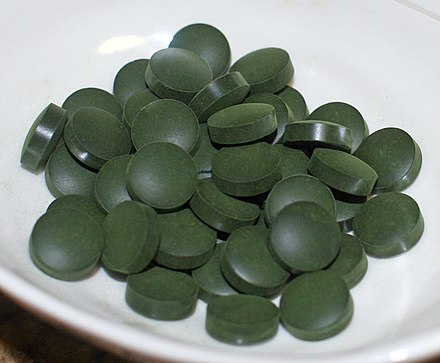
Spirulina is a biomass of cyanobacteria (blue-green algae) that can be consumed by humans and animals. The three species are Arthrospira platensis, A. fusiformis, and A. maxima.
Cultivated worldwide, Arthrospira is used as a dietary supplement or whole food. It is also used as a feed supplement in the aquaculture, aquarium,
and poultry industries.As an ecologically sound,
nutrient-rich dietary supplement,
spirulina is being investigated to address food security and malnutrition,
and as dietary support in long-term space flight or Mars missions.Its
advantage for food security is that it needs less land and water than livestock to
produce protein and energy.
|
Tribulus Terrestris
https://en.wikipedia.org/wiki/Tribulus_terrestris

Tribulus terrestris is
an annual plant in
the caltrop family (Zygophyllaceae)
widely distributed around the world. It
is adapted to grow in dry climate locations in which few other plants can survive. It is native to warm temperate and tropical regions in southern Eurasia and Africa.
It has been unintentionally introduced to North America and Australia.
An aggressive and hardy invasive species, T.
terrestris is widely known
as a noxious weed because of its small woody fruit – the bur –
having long sharp and strong spines which easily penetrate surfaces such as the bare feet or thin shoes of crop workers and other pedestrians,
the rubber of bicycle tires, and the mouths and skin of grazing animals.
The phytochemistry of T. terrestris samples collected from various parts of the world differs significantly. Among the steroidal saponins present in this herb, furostanol saponins are isolated only from T. terrestris of Bulgarian origin. One of the main chemical compounds found in T. terrestris is protodioscin.
Two alkaloids that seem to cause limb paresis (staggers) in sheep that eat Tribulus terrestulis are the beta-carboline alkaloids harman (harmane)
and norharman (norharmane). The alkaloid content of dried foliage is about 44 mg/kg.
|
Triphala Extract
https://en.wikipedia.org/wiki/Triphala

Triphala ("three
fruits") is an Ayurvedic herbal rasayana formula
consisting of equal parts of three myrobalans, taken without seed: Amalaki (Phyllanthus
emblica), Bibhitaki (Terminalia
bellirica), and Haritaki (Terminalia
chebula). One report indicates it contains vitamin C. |
Yohimbine
https://en.wikipedia.org/wiki/Yohimbine

Yohimbine (), also
known as quebrachine, is an indoloquinolizidine alkaloid derived
from the bark of the African tree Pausinystalia johimbe; also from the bark of the unrelated South American tree Aspidosperma
quebracho-blanco. Yohimbine is an alpha-2 adrenergic antagonist,
and has been used in a variety of research projects. It is a veterinary drug used to reverse sedation in dogs and deer.Yohimbine has high affinity for
the α2-adrenergic
receptor, moderate affinity for the α1 receptor, 5-HT1A, 5-HT1B, 5-HT1D, 5-HT1F, 5-HT2B,
and dopamine D2 receptors,
and weak affinity for the 5-HT1E, 5-HT2A, 5-HT5A, 5-HT7,
and dopamine D3 receptors. It
behaves as an antagonist at α1-adrenergic,
α2-adrenergic, 5-HT1B, 5-HT1D,
5-HT2A, 5-HT2B, and dopamine D2,
and as a partial agonist at 5-HT1A.[31][33][34][35] Yohimbine
interacts with serotonin and dopamine receptors in high concentrations. |
| Nutraceuticals |
Astaxanthin
https://en.wikipedia.org/wiki/Astaxanthin

Astaxanthin is a blood-red pigment and is produced naturally in the freshwater microalgae Haematococcus pluvialis and the yeast fungus Xanthophyllomyces dendrorhous (also known as Phaffia). When the algae is stressed by lack of nutrients, increased salinity, or excessive sunshine, it creates
astaxanthin. Animals who feed on the algae, such as salmon, red trout, red sea bream, flamingos, and crustaceans (i.e. shrimp, krill, crab, lobster, and crayfish), subsequently reflect the red-orange astaxanthin pigmentation to various degrees.The structure of astaxanthin by synthesis was described in 1975. Astaxanthin is not converted to vitamin A in the human body so it is completely nontoxic if given orally.Astaxanthin can also be used as a dietary supplement intended for human, animal, and aquaculture consumption. Astaxanthin
is used as a dietary supplement and
feed supplement as food colorant for
salmon, crabs, shrimp, chickens and egg production.
|
Beta Carotene
https://en.wikipedia.org/wiki/Beta-Carotene

β-Carotene is
an organic,
strongly colored red-orange pigment abundant
in fungi,[5] plants,
and fruits. It is a member of the carotenes,
which are terpenoids (isoprenoids),
synthesized biochemically from eight isoprene units
and thus having 40 carbons.
Among the carotenes, β-carotene is distinguished by having beta-rings at
both ends of the molecule.
β-Carotene is biosynthesized from geranylgeranyl pyrophosphate.Plant
carotenoids are the primary dietary source of provitamin A worldwide, with β-carotene as the best-known provitamin A
carotenoid. Others include α-carotene and β-cryptoxanthin.
Carotenoid absorption is restricted to the duodenum of
the small intestine and dependent on class B scavenger receptor (SR-B1)
membrane protein, which is also responsible for the absorption of vitamin E (α-tocopherol). |
Bromelain
https://en.wikipedia.org/wiki/Bromelain
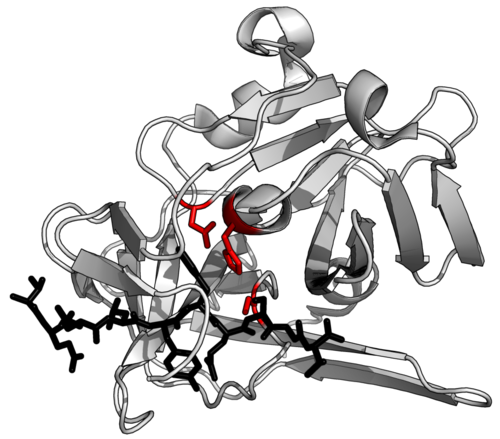
Bromelain is an enzyme extract derived from the stems of pineapples, although it exists in all parts of the fresh pineapple. The extract has a history of folk medicine use. As an ingredient, it is used in cosmetics,
as a topical medication, and as a meat tenderizer.The term "bromelain" may refer to either of two protease enzymes extracted from the plants of the family Bromeliaceae, or it may refer to a combination of those enzymes along with other compounds produced in an extract. Bromelain enzymes are called fruit bromelain and stem bromelain.though tested in a variety of folk medicine and research models for its possible efficacy against diseases, the only approved clinical application for bromelain was issued in 2012 by the European Medicines Agency for a topical medication called NexoBrid used
to remove dead tissue in severe skin burns.
|
Camphor
https://en.wikipedia.org/wiki/Camphor

Camphor () is a waxy, flammable, transparent solid with
a strong aroma. It is a terpenoid with the chemical formula C10H16O.
It is found in the wood of the camphor laurel (Cinnamomum camphora), a large evergreen tree found in East Asia, also of the unrelated kapur tree (Dryobalanops
sp.), a tall timber tree from South East Asia. It also occurs in some other related trees in the laurel family, notably Ocotea usambarensis. Rosemary leaves (Rosmarinus
officinalis) contain 0.05 to 0.5% camphor, while camphorweed (Heterotheca) contains some 5%. A major source of camphor in Asia is camphor basil (the parent of African blue basil). Camphor can also be synthetically produced from oil of turpentine.The molecule has two possible enantiomers as shown in the structural
diagrams. The structure on the left is the naturally occurring (+)-camphor ((1R,4R)-bornan-2-one), while its mirror image shown on the right is the (−)-camphor ((1S,4S)-bornan-2-one).It is used for its scent, as an ingredient in cooking (mainly in India), as an embalming fluid, for medicinal purposes, and in religious ceremonies.
|
Capsaicin
https://en.wikipedia.org/wiki/Capsaicin

Capsaicin (8-methyl-N-vanillyl-6-nonenamide)
is an active component of chili peppers, which are plants belonging to the genus Capsicum.
It is a chemical irritant for
mammals, including humans, and produces a sensation of burning in any tissue with which it comes into contact. Capsaicin and several related compounds are called capsaicinoids and
are produced as secondary metabolitby
chili peppers, probably as deterrents against certain mammals and fungi. Pure
capsaicin is a hydrophobic, colorless, highly pungent,[2] crystalline
to waxy solid compound.The burning and painful sensations associated with capsaicin result from its chemical interaction with sensory neurons. Capsaicin, as a member of the vanilloid family,
binds to a receptor called the vanilloid
receptor subtype 1 (TRPV1). First cloned in 1997, TRPV1 is an ion channel-type receptor. TRPV1, which can also be stimulated with heat, protons and physical abrasion, permits cations to
pass through the cell membrane when activated. The resulting depolarization of
the neuron stimulates it to signal the brain. By binding to the TRPV1 receptor, the capsaicin molecule produces similar sensations to those of excessive heat or abrasive damage, explaining why the spiciness of capsaicin is described as a burning sensation. |
Cassia Occidentalis
https://en.wikipedia.org/wiki/Senna_occidentalis

Senna occidentalis is a pantropical plant species.
Vernacular names include ʻauʻaukoʻi in Hawaii, septicweed, coffee senna,coffeeweed, Mogdad coffee, negro-coffee, senna coffee, Stephanie coffee, stinkingweed or styptic weed.The plant is locally called Bana Chakunda in Odisha, India.The species was formerly placed in the genus Cassia.The plant is reported to be poisonous to cattle. The plant contains anthraquinones. The roots contain emodin and the seeds contain chrysarobin (1,8-dihydroxy-3-methyl-9-anthrone) and N-methylmorpholine.Mogdad coffee seeds can be roasted and used as a substitute for coffee. They have also been used as an adulterant for
coffee. There is apparently no caffeine in mogdad coffee.Despite the claims of being poisonous, the leaves of this plant, Dhiguthiyara in the Maldivian language, have been used in the diet of the Maldives for centuries in dishes such as mas
huni and also as a medicinal plant.z This plant is mainly used for the treatment of bone fractures and bone dislocation as an herbal treatment in India.
|
Centella Asiatica
https://en.wikipedia.org/wiki/Centella_asiatica

Centella asiatica, commonly known as Indian
pennywort or Asiatic
pennywort, is a herbaceous, perennial
plant in the flowering
plant family Apiaceae. It
is native to the wetlands in Asia. It
is used as a culinary vegetable and
as a medicinal herb.Centella contains
pentacyclic triterpenoids, including asiaticoside, brahmoside, asiuyatic
acid, and brahmic acid (madecassic acid). Other constituents include centellose, centelloside,
and madecassoside.In the context of phytoremediation, C.
asiatica is a potential phytoextraction tool owing to its ability to take up and translocate metals
from root to shoot when grown in soils contaminated by heavy metals. |
Chondroitin Sulphate Sodium
https://en.wikipedia.org/wiki/Chondroitin_sulfate

Chondroitin sulfate is
a sulfated glycosaminoglycan (GAG)
composed of a chain of alternating sugars (N-acetylgalactosamine and glucuronic
acid). It is usually found attached to proteins as part of a proteoglycan. A chondroitin chain can have over 100 individual sugars, each of which can be sulfated in variable positions and quantities. Chondroitin sulfate is an important structural component of cartilage and
provides much of its resistance to compression. Along
with glucosamine, chondroitin sulfate has become a widely used dietary
supplement for treatment of osteoarthritis.The
effect of chondroitin sulfate in people with osteoarthritis is likely the result of a number of reactions including its anti-inflammatory activity, the stimulation of the synthesis of proteoglycans and hyaluronic acid, and the decrease in catabolic activity of chondrocytes, inhibiting the synthesis of proteolytic enzymes, nitric oxide, and other substances that contribute to damage the cartilage matrix and cause death of articular chondrocytes. |
Cissus Quadrangularis
https://en.wikipedia.org/wiki/Cissus_quadrangularis

Cissus quadrangularis is
a perennial plant of the grape family.
It is commonly known as veldt grape, devil's
backbone, adamant
creeper, asthisamharaka, hadjod and pirandai. The
species is native to tropical Asia, Arabia and
much of Africa.Cissus quadrangularis has
been used as a medicinal plant since antiquity.[citation
needed] Cissus has
been used in various Ayurvedic classical medicines to heal broken bones and injured ligaments and tendons.C. quadrangularis has
been found to contain carotenoids, triterpenoids,
and ascorbic acid. The
plant also produces the resveratrol dimer quadrangularin A. |
Citrus Aurantium
https://en.wikipedia.org/wiki/Bitter_orange
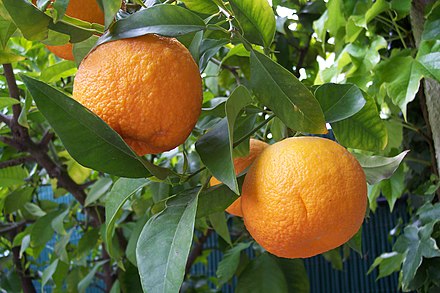
Bitter orange, Seville
orange, sour
orange, bigarade
orange, or marmalade orange is
the citrus tree Citrus × aurantium and
its fruit.
Many varieties of bitter orange are used for their essential oil, and are found in perfume, used as a flavoring or as a solvent, and also for consumption. The Seville orange variety is used in the production of marmalade and
also used to make French bigarade.
Bitter orange is also employed in herbal medicine as a stimulant and appetite suppressant, due to its active ingredient, synephrine.
|
Citrus Bioflavonoids
https://en.wikipedia.org/wiki/Flavonoid
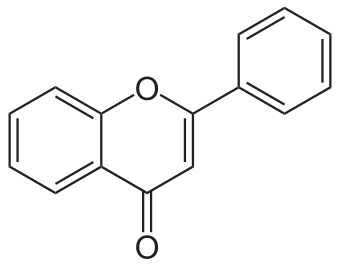
Flavonoids (or bioflavonoids) (from the Latin word flavus, meaning yellow, their color in nature) are a class of polyphenolic secondary metabolites found in plants, and thus commonly consumed in diets.
Chemically, flavonoids have the general structure of a 15-carbon skeleton, which consists of two phenyl rings (A and B) and a heterocyclic ring (C).
Flavonoids are widely distributed in plants, fulfilling many functions. Flavonoids
are the most important plant pigments for
flower coloration, producing yellow or red/blue pigmentation in petals designed to attract pollinator animals.
In higher plants, flavonoids are involved in UV filtration, symbiotic nitrogen fixation and floral pigmentation. They may also act as chemical messengers, physiological regulators, and cell cycle inhibitors. |
Coenzyme Q1o
https://en.wikipedia.org/wiki/Coenzyme_Q10

Coenzyme Q, also known as ubiquinone, is a coenzyme family that is ubiquitous in animals and most bacteria (hence the name ubiquinone). In humans, the most common form is Coenzyme Q10 or ubiquinone-10. CoQ10 is
not approved by the U.S. Food and Drug Administration (FDA) for the treatment of any medical condition; however, it is sold as a dietary supplement and is an ingredient in some cosmetics.It is a 1,4-benzoquinone, where Q refers to the quinone chemical group and 10 refers to the number of isoprenyl chemical subunits in its tail. In natural ubiquinones, the number can be anywhere from 6 to 10. This family of fat-soluble substances, which resemble vitamins,
is present in all respiring eukaryotic cells, primarily in the mitochondria. It is a component of the electron transport chain and participates in aerobic cellular respiration, which generates energy in the form of ATP
|
Colchicine
https://en.wikipedia.org/wiki/Colchicine

Colchicine is
a medication used to treat gout and Behçet's
disease. In
gout, it is less preferred to NSAIDs or steroids. Other
uses for colchicine include the prevention of pericarditis and familial
Mediterranean fever.Generally, colchicine appears to inhibit multiple proinflammatory mechanisms, while enabling increased levels of anti-inflammatory mediators.
Apart from inhibiting mitosis, colchicine inhibits neutrophil motility and activity, leading to a net anti-inflammatory effect, which has efficacy for inhibiting or preventing gout inflammation. |
Glucosamine Sulphate
https://en.wikipedia.org/wiki/Glucosamine

Glucosamine (C6H13NO5) is an amino sugar and a prominent precursor in the biochemical synthesis of glycosylated proteins and
lipids. Glucosamine is part of the structure of the polysaccharides, chitosan, and chitin. Glucosamine is one of the most abundant monosaccharides. Produced commercially by the hydrolysis of shellfish exoskeletons or,
less commonly, by fermentation of a grain such as corn or wheat, glucosamine has many names depending on country. Although a common dietary supplement, there is little evidence that it is effective for relief of arthritis or pain, and is not an approved prescription drug.
|
Ipriflavone
https://en.wikipedia.org/wiki/Ipriflavone

Ipriflavone (INN, JAN; brand name Yambolap) is a synthetic isoflavone which may
be used to inhibit bone resorption, maintain bone density and to prevent osteoporosis in postmenopausal women.It is not used to treat osteoporosis. It slows down the action of the osteoclasts (bone-eroding cells), possibly allowing the osteoblasts (bone-building cells) to build up bone mass.A clinical trial reported in 2001 that it was not effective in prevention or treatment of osteoporosis. double-blind study reveals that ipriflavone might be effective on reducing tinnitus on otosclerosis sufferers.Ipriflavone has been described as a phytoestrogen.However, this is incorrect, as the drug does not bind to or activate the estrogen receptor and shows no estrogenic effects in postmenopausal women. The
drug prevents bone loss via mechanisms that are distinct from those of estrogens.
|
Lutein
https://en.wikipedia.org/wiki/Lutein

Lutein (; from Latin luteus meaning
"yellow") is a xanthophyll and one of 600 known naturally occurring carotenoids. Lutein is synthesized only by plants, and like other xanthophylls is found in high quantities in green leafy vegetables such as spinach, kale and
yellow carrots. In green plants, xanthophylls act to modulate light energy and serve as non-photochemical quenching agents to deal with triplet chlorophyll (an excited form of chlorophyll), which is overproduced at very high light levels, during photosynthesis. See xanthophyll cycle for this topic.Animals obtain lutein by ingesting plants. In the human retina, lutein is absorbed from blood specifically into the macula lutea, although its precise role in the body is unknown. Lutein is also found in egg yolks and animal fats.The
lutein market is segmented into pharmaceutical, dietary supplement, food, pet food, and animal and fish feed.
|
Lycopene
https://en.wikipedia.org/wiki/Lycopene

Lycopene (from
the neo-Latin Lycopersicum,
the tomato species) is a bright red carotenoid hydrocarbon found
in tomatoes and
other red fruits and vegetables, such as red carrots, watermelons, grapefruits,
and papayas, but it is not present in strawberries or cherries.Although
lycopene is chemically a carotene, it has no vitamin A activity Foods
that are not red may also contain lycopene, such as asparagus, guava and parsley.Absorption
of lycopene requires that it be combined with bile salts and
fat to form micelles. Intestinal
absorption of lycopene is enhanced by the presence of fat and by cooking. Lycopene dietary supplements (in oil) may be more efficiently absorbed than lycopene from food. |
Mango Butter
https://en.wikipedia.org/wiki/Mango_oil

Mango oil, a.k.a. mango
kernel fat, or, mango
butter, is an oil fraction obtained
during the processing of mango butter. Mango oil is a seed oil extracted
from the stone of the fruit of the Mangifera indica (mango).
The oil is semi-solid at room temperatures, but melts on contact with warm skin, making it appealing for baby creams, suncare balms, hair products, and other moisturizing products. The oil is a soft yellow color with a melting point of 32–42 °C (90–108 °F). |
Methoxsalen
https://en.wikipedia.org/wiki/Methoxsalen

Methoxsalen (also
called xanthotoxin), sold under the brand name Oxsoralen among
others, is a drug used
to treat psoriasis, eczema, vitiligo,
and some cutaneous lymphomas in
conjunction with exposing the skin to UVA light from lamps or sunlight. Methoxsalen modifies the way skin cells receive the UVA radiation,
allegedly clearing up the disease. The dosage comes in 10 mg tablets, which are taken in the amount of 30 mg 75 minutes before a PUVA (psoralen + UVA)
light treatment. Levels of individual patient PUVA exposure were originally determined using the Fitzpatrick scale. The scale was developed after patients demonstrated symptoms of phototoxicity after
oral ingestion of Methoxsalen followed by PUVA therapy. Chemically, methoxsalen belongs to a class of organic natural molecules known as furanocoumarins. They consist of coumarin annulated with furan. |
Methyl Sulphonyl Methane
thttps://en.wikipedia.org/wiki/Methylsulfonylmethane
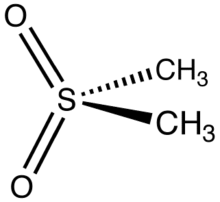
Methylsulfonylmethane (MSM)
is an organosulfur compound with
the formula (CH3)2SO2.
It is also known by several other names including methyl sulfone and dimethyl
sulfone (DMSO2). This
colorless solid features the sulfonyl functional
group and is considered
relatively inert chemically. It occurs naturally in some primitive plants, is present in small amounts in many foods and beverages, and is marketed as a dietary supplement. It is sometimes used as a cutting agent for illicitly manufactured methamphetamine. It
is also commonly found in the atmosphere above marine areas, where it is used as a carbon source by the airborne bacteria Afipia.MSM
and the corresponding sulfoxide, dimethyl sulfoxide ((CH3)2SO,
or DMSO), have different physical properties. MSM is a white crystalline solid at room temperature (m.p. = 109 °C) whereas DMSO is typically a liquid (m.p. = 19 °C). The sulfoxide is a highly polar
aprotic solvent and is miscible with water; it is also an excellent ligand. MSM is less reactive than DMSO because the S-atom of the sulfone is already in its highest oxidation state (VI). Indeed, oxidation of the sulfoxide produces the sulfone, both under laboratory conditions and metabolically. |
Phytosterols
https://en.wikipedia.org/wiki/Phytosterol

Phytosterols, which encompass plant sterols and stanols,
are phytosteroids, similar to cholesterol,
which occur in plants and
vary only in carbon side chains and/or presence or absence of a double bond. Stanols
are saturated sterols,
having no double bonds in the sterol ring structure. More than 200 sterols and related compounds have been identified. Free
phytosterols extracted from oils are insoluble in water, relatively insoluble in oil, and soluble in alcohols.
As common sources of phytosterols, vegetable oils have been developed as margarine products highlighting phytosterol content. Cereal products, vegetables, fruit and berries, which are not as rich in phytosterols, may also be significant sources of phytosterols due to their higher intakes.
|
Piperine
https://en.wikipedia.org/wiki/Piperine
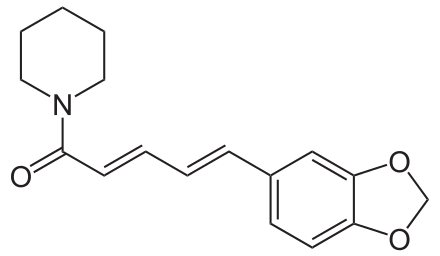
Piperine, along with its isomer chavicine,
is the alkaloid responsible
for the pungency of black
pepper and long
pepper. It has been used in some forms of traditional medicine.Piperine
is extracted from black pepper by
using dichloromethane. Aqueous
hydrotropes can be used in the extraction to result in high yield and selectivity. The amount of piperine varies from 1–2% in long pepper, to 5–10% in commercial white and black peppers.[4] Further, it may be prepared by treating the solvent-free residue from an alcoholic extract of black
pepper, with a solution of potassium hydroxide to remove resin (said to contain chavicine,
an isomer of piperine) and solution of the washed, insoluble residue in warm alcohol, from which the alkaloid crystallises on cooling. |
Silymarin
https://en.wikipedia.org/wiki/Silibinin

Silibinin (INN),
also known as silybin (both from Silybum,
the generic name
of the plant from
which it is extracted), is the major active constituent of silymarin, a standardized extract of the milk
thistle seeds, containing a
mixture of flavonolignans consisting
of silibinin, isosilibinin, silichristin, silidianin,
and others. Silibinin itself is a mixture of two diastereomers,
silybin A and silybin B, in approximately equimolar ratio. The
mixture exhibits a number of pharmacological effects, particularly in the fatty liver, NAFLD, NASH, and there is great clinical evidence for the use of silibinin as a supportive element in alcoholic and child grade 'A' liver cirrhosis. |
Soy Isoflavones
https://en.wikipedia.org/wiki/Soybean#Isoflavones

soflavonoids are a class of flavonoid phenolic compounds, many of which are biologically active. Isoflavonoids and their derivatives are sometimes referred to as phytoestrogens, as many isoflavonoid compounds have biological effects via the estrogen receptor.
Medically, isoflavonoids and related compounds have been used in many dietary supplements, but the medical and scientific community is generally skeptical of their use. Recently, some natural isoflavonoids have been identified as toxins, including biliatresone which may cause biliary atresia when infants are exposed to the plant product.
|
Tetra Hydro Curcuminoids
https://en.wikipedia.org/wiki/Curcuminoid

A curcuminoid is
a linear diarylheptanoid, with molecules such as curcumin or derivatives of
curcumin with different chemical groups that
have been formed to increase solubility of
curcumins and make them suitable for drug formulation. The
curcumin derivatives demethoxycurcumin and bisdemethoxycurcumin have, like curcumin itself, been tested for their antioxidant activities in
vitro. Antioxidants can be used to extend the shelf life for food and maintain their safety, nutritional quality, functionality and palatability. Pure
chemicals of curcumin and its derivatives are not available in the open market. Commercially available curcumin contains 77% curcumin, 17% demethoxycurcumin and 3% bisdemethoxycurcumin from the herb Curcuma
longa. Curcumin is mainly produced in industry as pigment by
using turmeric oleoresin as the starting material which curcuminoids can
be isolated from. |
Zeaxanthin
https://en.wikipedia.org/wiki/Zeaxanthin

Zeaxanthin is
one of the most common carotenoid alcohols found in nature. It is important in the xanthophyll cycle. Synthesized in plants and some micro-organisms, it is the pigment that gives paprika (made
from bell peppers), corn, saffron, wolfberries,
and many other plants and microbes their characteristic color.
As a food additive, zeaxanthin is a food dye with E number E161h.
|
| Probiotics |
Bacillus Clausii
https://en.wikipedia.org/wiki/Bacillus_clausii

Bacillus clausii is a rod-shaped, Gram-positive, motile and spore-forming bacterium that lives in the soil. It is classified as probiotic microorganism that maintains a symbiotic
relationship with the host organism It is currently being studied in respiratory infections and some gastrointestinal disorders. Bacillus clausii has been found to produce antimicrobial substances that are active against gram positive bacteria including Staphylococcus aureus, Enterococcus faecium and Clostridium
difficile.It is sold by Sanofi as Enterogermina.Bacillus clausii has a relatively small genome that contains 4.30 Mbp with 4,108 protein coding genes.
|
Bacillus Mesentericus
https://en.wikipedia.org/wiki/Bacillus_mesentericus

Bacillus mesentericus is a Gram-positive species of bacteria. Strains of this species may contaminate bread dough, forming a sticky, rope-like texture.
This species has been experimentally explored as a potential probiotic
|
Bacillus Subtilis
https://en.wikipedia.org/wiki/Bacillus_subtilis
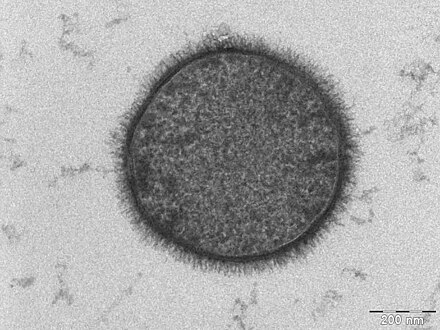
Bacillus subtilis, known also as the hay
bacillus or grass
bacillus, is a Gram-positive, catalase-positive bacterium,
found in soil and the gastrointestinal tract of ruminants and
humans. A member of the genus Bacillus, B.
subtilis is rod-shaped, and
can form a tough, protective endospore, allowing it to tolerate extreme environmental conditions. B.
subtilis has historically
been classified as an obligate aerobe, though evidence exists that it is a facultative
anaerobe. B.
subtilis is considered the
best studied Gram-positive bacterium and a model organism to
study bacterial chromosome replication and cell differentiation. It is one of the bacterial champions in secreted enzyme production
and used on an industrial scale by biotechnology companies. |
Bifidobacterium Bifidum
https://en.wikipedia.org/wiki/Bifidobacterium_bifidum

Bifidobacterium bifidum is
a bacterial species of the genus Bifidobacterium. B.
bifidum is one of the most
common probiotic bacteria
that can be found in the body of mammals,
including humans.B. bifidum is
a Gram-positive bacterium that is not
motile, anaerobic,
and not spore-forming. The bacterium is rod-shaped and can be found living in clusters, pairs, or even independently. The majority of the population of B. bifidum is found in the colon,
lower small intestine, breast milk, and often in the vagina. B.
bifidum is an essential bacteria found in the human intestine. When it is low or absent all together in the human intestine, it is an indication of being in an unhealthy state. Intestinal flora can be improved if someone takes oral B. bifidum. Also, oral B.
bifidum is used for other things such as therapy for enteric and hepatic disorders, for activating the immune response, and for preventing some cancers. B. bifidum decreases as people age. As B.
bifidum decreases, other gut bacteria such as Lactobacilli, Enterococci, Enterobacteria and Clostridia increase.
All of these increase an older adults risk for cancer and decrease the ability for their liver to function adequately and efficiently. |
Bifidobacterium Infantis
https://en.wikipedia.org/wiki/Bifidobacterium_longum

Bifidobacterium longum is
a Gram-positive, catalase-negative,
rod-shaped bacterium present in the human gastrointestinal tract and one of the 32 species that belong to the genus Bifidobacterium. It
is a microaerotolerant anaerobe and
considered to be one of the earliest colonizers of the gastrointestinal tract of infants. When
grown on general anaerobic medium, B. longum forms
white, glossy colonies with a convex shape. While B.
longum is not significantly
present in the adult gastrointestinal tract, it is considered part of the gut microbiota and
its production of lactic acid is
believed to prevent growth of pathogenic organisms. B. longum is
non-pathogenic and is often added to food products. |
Clostridium Butvricum
https://en.wikipedia.org/wiki/Clostridium_butyricum

Clostridium butyricum is
a strictly anaerobic endospore-forming Gram-positive butyric
acid–producing bacillus subsisting
by means of fermentation using
an intracellularly accumulated amylopectin-like α-polyglucan (granulose) as a substrate. It is uncommonly reported as a human pathogen and is widely used as a probiotic in
Asia (particularly in Japan, Korea and China). C. butyricum is
a soil inhabitant in various parts of the world, has been cultured from the stool of healthy children and adults, and is common in soured milk and cheeses. |
Enterococcus Faecium
https://en.wikipedia.org/wiki/Enterococcus_faecium

Enterococcus faecium is a Gram-positive, alpha-hemolytic or non-hemolytic bacterium in the genus Enterococcus.It
can be commensal (innocuous, coexisting organism) in the gastrointestinal tract of humans and animals, but it may also be pathogenic, causing diseases such as neonatal meningitis or endocarditis.
Vancomycin-resistant E. faecium is often referred to as VRE.
|
Lactobacillus Acidophilus
https://en.wikipedia.org/wiki/Lactobacillus_acidophilus

Lactobacillus acidophilus (New
Latin 'acid-loving
milk-bacillus') is a species of gram positive bacteria in
the genus Lactobacillus. L.
acidophilus is a homofermentative, microaerophilic species,
fermenting sugars into lactic
acid, and grows readily at rather low pH values (below pH 5.0) and has an optimum growth temperature of around 37 °C (99 °F). L.
acidophilus occurs
naturally in the human and animal gastrointestinal tract and mouth.
L. acidophilus was found to lower serum cholesterol and raise cholesterol in fecal matter when fed to pigs.
L. acidophilus is found to also reduce oral plaque formation by Streptococcus
mutans. |
Lactobacillus Casei
https://en.wikipedia.org/wiki/Lactobacillus_casei

Lactobacillus casei is
a species of genus Lactobacillus.
This particular species of Lactobacillus is
documented to have a wide pH and temperature range, and complements the growth of L. acidophilus, a producer of the enzyme amylase (a carbohydrate-digesting
enzyme).
The most common application of L. casei is
industrial, specifically for dairy production.
In the preparation of food, L. casei bacteria can be used in the natural fermentation of beans to lower levels of the compounds causing flatulence upon digestion. Among the best-documented, probiotic L.casei, L.
casei DN-114001, and L. casei Shirota have been extensively studied[9] and
are widely available as functional foods (see Actimel, Yakult). |
Lactobacillus Lactis
https://en.wikipedia.org/wiki/Lactobacillus_delbrueckii

Lactobacillus delbrueckii is
a species of bacteria in the family Lactobacillaceae. It is part of the microbiota
of the lower reproductive tract of women.The species carries the name of Max
Delbrück, who lent his name to the Berlin Institute for the Fermentation Industries, where L. delbrueckii and L.
delbrueckii subsp. bulgaricus were
produced on an industrial scale from about 1896. |
Lactobacillus Plantarum
https://en.wikipedia.org/wiki/Lactobacillus_plantarum

Lactobacillus plantarum is
a widespread member of the genus Lactobacillus, commonly found in many fermented food products as well as anaerobic plant matter. It is also present in saliva (from
which it was first isolated).The entire genome has recently been sequenced, and promoter libraries
have been developed for both conditional and constitutive gene expression, adding to the utility of L. plantarum. It is also commonly employed as the indicative organism in niacin bioassay experiments,
in particular, AOAC International Official Method 944.13, as it is a niacin auxotroph. |
Lactobacillus Reuteri
https://en.wikipedia.org/wiki/Lactobacillus_reuteri

Furthermore, a study searching for 18 major species in the gut
microbiota, including L. acidophilus, in a variety of animals found that L.
reuteri was the only
species to constitute a "major component" of the Lactobacillus species
present in the gut of each of the tested host animals. It
is one of the most ubiquitous members of the mammalian gut microbiota.One of the better documented effects of L. reuteri is in the treatment of diarrheal diseases in children,
where it significantly decreases symptom duration. Treatment of rotaviral diarrhea with L.
reuteri significantly shortens the duration of the illness as compared to placebo. This effect is dose-dependent: the more L.
reuteri consumed, the faster the diarrhea stops. |
Lactobacillus Rhamnosus
https://en.wikipedia.org/wiki/Lactobacillus_rhamnosus

Lactobacillus rhamnosus is
a bacterium that
originally was considered to be a subspecies of L. casei, but genetic research found it to be a species of its own. It is a short Gram-positive heterofermentative facultative
anaerobic non-spore-forming
rod that often appears in chains. Some strains of L. rhamnosus bacteria
are being used as probiotics, and are particularly useful in treating female-related infections, most particularly very difficult to treat cases of bacterial
vaginosis (or "BV"). The Lactobacillus
rhamnosus and L.
reuteri species are
most commonly found in the healthy female genito-urinary tract and are most helpful to supplement in order to regain control over dysbiotic bacterial overgrowth during an active infection. L. rhamnosus sometimes
is used in yogurt and dairy
products such as fermented
and unpasteurized milk and semi-hard cheese. |
Lactobacillus Sporogenes (Bacillus Coagulans)
https://en.wikipedia.org/wiki/Bacillus_coagulans

Bacillus coagulans is
a lactic acid-forming bacterial species. The organism was first isolated and described as Bacillus
coagulans in 1915 by B.W.
Hammer at the Iowa Agricultural Experiment Station as a cause of an outbreak of coagulation in evaporated milk packed by an Iowa condensary.Bacillus coagulans has been added by the EFSA to
their Qualified Presumption of Safety list[4] and has been approved for veterinary purposes as GRAS by
the U.S. Food and Drug Administration's Center for Veterinary Medicine, as well as by the European
Union, and is listed by AAFCO for use as a direct-fed microbial in livestock production. It is often used in veterinary applications, especially as a probiotic in
pigs, cattle, poultry, and shrimp. Many references to use of this bacterium in humans exist, especially in improving the vaginal flora, improving abdominal pain and bloating in irritable bowel syndrome patients, and increasing immune response to viral challenges. |
Saccharomyces Boulardii
https://en.wikipedia.org/wiki/Saccharomyces_boulardii

Saccharomyces boulardii is
a tropical species of yeast first
isolated from lychee and mangosteen fruit
in 1923 by French scientist Henri Boulard.
S. boulardii is sometimes used as a probiotic with the purpose of
introducing beneficial microbes into the large and small intestines and conferring protection against pathogens. |
| |
Streptococcus Faecalis
https://en.wikipedia.org/wiki/Enterococcus_faecalis

Enterococcus faecalis –
formerly classified as part of the group D Streptococcus system
– is a Gram-positive, commensal bacterium inhabiting
the gastrointestinal tracts of
humans and other mammals. Like
other species in the genus Enterococcus, E.
faecalis is
found in healthy humans, but can cause life-threatening infections, especially in the nosocomial (hospital)
environment, where the naturally high levels of antibiotic resistance found
in E. faecalis contribute
to its pathogenicity.
|
Streptococcus Thermophilus
https://en.wikipedia.org/wiki/Streptococcus_thermophilus

Streptococcus thermophilus also known as Streptococcus salivarius subsp. thermophilus is a gram-positive bacterium, and a fermentative facultative
anaerobe, of the viridans group. It tests negative for cytochrome, oxidase, and catalase, and positive for alpha-hemolytic activity. It
is non-motile and does not form endospores. S. thermophilus is fimbriated.It is also classified as a lactic acid bacterium. S. thermophilus is found in fermented milk products, and is generally used in the production of yogurt, alongside Lactobacillus
delbrueckii subsp. bulgaricus. The two species are synergistic, and S. thermophilus probably provides L. d. bulgaricus with folic acid and formic acid which it uses for purine synthesis.
|
| Refined/Organic/Virgin Oils |
Almond
https://en.wikipedia.org/wiki/Almond
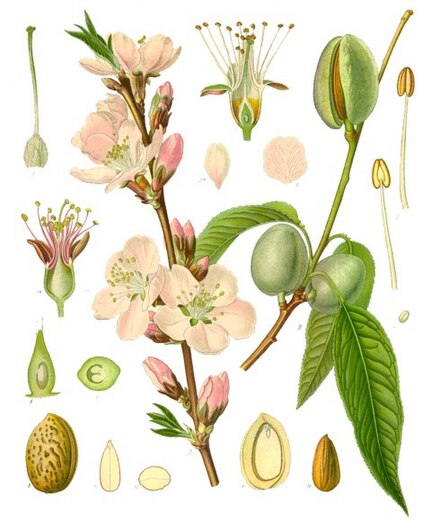
The almond (Prunus
dulcis, syn. Prunus
amygdalus) is a species of tree native to Iran and
surrounding countries[3][4] but
widely cultivated elsewhere. The almond is also the name of the edible and widely cultivated seed of
this tree.The almond is a nutritionally dense food (table), providing a rich source (20% or more of the Daily Value, DV) of the B
vitamins riboflavin and niacin, vitamin
E, and the essential minerals calcium, copper, iron, magnesium, manganese, phosphorus,
and zinc. Almonds are a moderate source (10–19% DV) of the B vitamins thiamine, vitamin
B6, and folate, choline, and the essential mineral potassium.
They also contain substantial dietary fiber, the monounsaturated
fat, oleic acid, and the polyunsaturated
fat, linoleic acid. Typical of nuts
and seeds, almonds are a source of phytosterols such as beta-sitosterol, stigmasterol, campesterol, sitostanol,
and campestanol. |
Anethole
https://en.wikipedia.org/wiki/Anethole

Anethole (also
known as anise camphor[citation
needed])
is an organic compound that
is widely used as a flavoring substance.
It is a derivative of phenylpropene,
a type of aromatic compound that occurs widely in nature, in essential oils.
Anethole is distinctly sweet, measuring 13 times sweeter than sugar. It is perceived as being pleasant to the taste even at higher concentrations. It is used in alcoholic drinks ouzo, rakı, anisette and absinthe,
among others. It is also used in seasoning and confectionery applications, oral hygiene products, and in small quantities in natural berry flavors.
Because they metabolize anethole into several aromatic chemical compounds, some bacteria are candidates for use in commercial bioconversion of anethole to more valuable materials. Bacterial strains capable of using trans-anethole as the sole carbon source include JYR-1 (Pseudomonas
putida) and TA13 (Arthrobacter aurescens).
|
Arachis
https://en.wikipedia.org/wiki/Arachis

Arachis is
a genus of
about 70 species of
annual and perennial flowering plants in
the pea family (Fabaceae), native to South America, and was recently assigned to the informal monophyletic Pterocarpus clade
of the Dalbergieae. At
least one species, the peanut (Arachis
hypogaea), is a major food crop species
of global importance; some of the other species are cultivated for food to a small extent in South America. Other species such as A. pintoi are
cultivated worldwide as forage and soil conditioner plants, with the leaves providing high-protein feed for grazing livestock and a nitrogen source in agroforestry and permaculture systems |
Asafoetida
https://en.wikipedia.org/wiki/Asafoetida

Asafoetida (;
also spelled asafetida)[1] is
the dried latex (gum oleoresin)
exuded from the rhizome or tap
root of several species of Ferula (F.
foetida and F.
assa-foetida), perennial herbs growing
1 to 1.5 m (3.3 to 4.9 ft) tall.This spice is used as a digestive aid, in food as a condiment, and in pickling. It plays a critical flavoring role in Indian vegetarian cuisine by acting as a savory enhancer. Used
along with turmeric, it is a standard component of lentil curries,
such as dal, chickpea curries,
and vegetable dishes, especially those based on potato and cauliflower. Asafoetida is used in vegetarian Indian Punjabi and South Indian cuisine where it enhances the flavor of numerous dishes |
Basil
https://en.wikipedia.org/wiki/Basil

Basil (, also ; Ocimum
basilicum), also called great basil, is a culinary herb of the family Lamiaceae (mints).
Basil is native to tropical regions from central Africa to Southeast Asia. It is a tender plant, and is used in cuisines worldwide. Depending on the species and cultivar, the leaves may taste somewhat like anise,
with a strong, pungent, often sweet smell.Basil is most commonly used fresh in recipes. In general, it is added at the last moment, as cooking quickly destroys the flavor. The fresh herb can be kept for a short time in plastic bags in the refrigerator, or for a longer period in the freezer, after being blanched quickly
in boiling water. The dried herb also loses most of its flavor, and what little flavor remains tastes very different, with a weak coumarin flavor,
like hay.
|
Boswellia
https://en.wikipedia.org/wiki/Boswellia

Boswellia is
a genus of trees in
the order Sapindales,
known for its fragrant resin. The biblical incense frankincense is
an extract from the resin of the tree Boswellia sacra, and is now produced also from B.
frereana. |
Caraway
https://en.wikipedia.org/wiki/Caraway
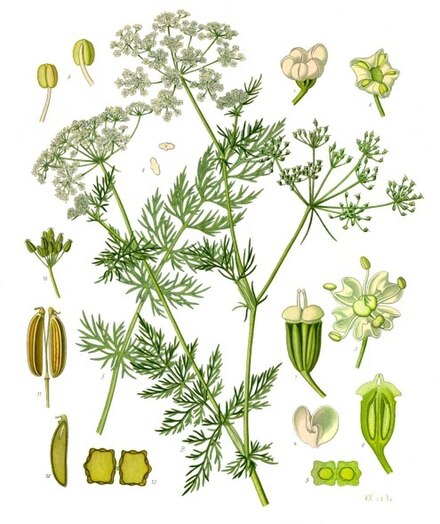
Caraway, also known as meridian
fennel and Persian
cumin (Carum
carvi), is a biennial plant in
the family Apiaceae, native
to western Asia, Europe, and North Africa.
The fruits, usually used whole, have a pungent, anise-like flavor and aroma that comes from essential oils, mostly carvone, limonene, and anethole. Caraway is used as a spice in breads,
especially rye bread.
Caraway is also used in desserts, liquors, casseroles, and other foods. Its leaves can be added to salads, stews, and soups, and are sometimes consumed as herbs, either raw, dried, or cooked, similar to parsley. The root is consumed as a winter root
vegetable in some places, similar to parsnips.
|
Cedar Leaf
https://en.wikipedia.org/wiki/Cedrus

Cedrus, common English name cedar,
is a genus of coniferous trees in
the plant family Pinaceae (subfamily
Abietoideae).
Cedars are adapted to mountainous climates; in the Mediterranean, they receive winter precipitation, mainly as snow, and summer drought, while in the western Himalaya, they receive primarily summer monsoon rainfall and occasional winter snowfall . While some naturalized Cedrus species grow in the Americas, none are native.
Cedars are used as food plants by the larvae of some Lepidoptera species including pine processionary and turnip moth (recorded on deodar cedar).
Cedars are very popular ornamental
trees, and are often cultivated in temperate climates where
winter temperatures do not fall below circa −25 °C. |
Clove Bud
https://en.wikipedia.org/wiki/Clove
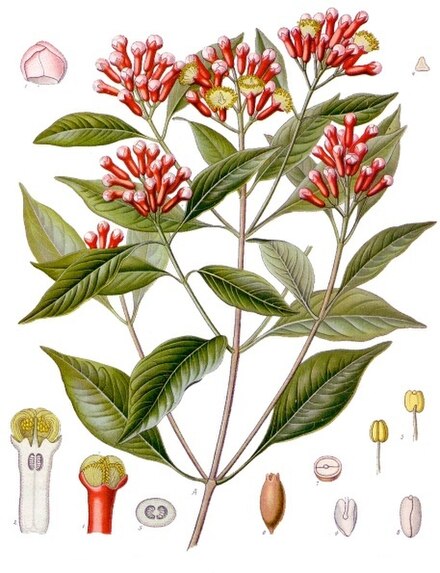
Cloves are
the aromatic flower buds of
a tree in the family Myrtaceae, Syzygium
aromaticum. They are native to the Maluku Islands (or
Moluccas) in Indonesia, and are commonly used as a spice.
Cloves are available throughout the year due to different harvest seasons in different countries.
Eugenol composes 72–90% of the essential oil extracted from cloves, and is the compound most responsible for clove aroma. Complete extraction occurs at 80 minutes in pressurized water at 125 °C (257 °F). Ultrasound-assisted and microwave-assisted extraction methods provide more rapid extraction rates with lower energy costs.
Other important essential oil constituents of clove oil include acetyl eugenol, beta-caryophyllene, vanillin, crategolic acid, tannins such as bicornin, gallotannic
acid, methyl salicylate (painkiller), the flavonoids eugenin, kaempferol, rhamnetin, and eugenitin,
triterpenoids such as oleanolic acid, stigmasterol, and campesterol and several sesquiterpenes. Eugenol has
not been classified for its potential toxicity.
|
Dill
https://en.wikipedia.org/wiki/Dill
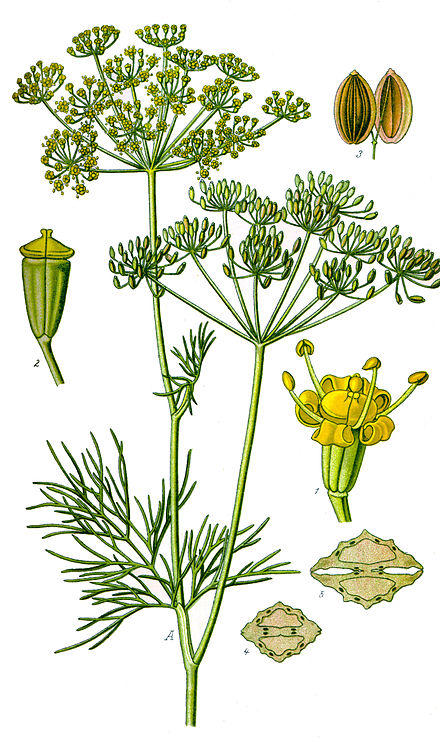
Dill (Anethum
graveolens) is an annual herb in
the celery family Apiaceae. It is the only species in the genus Anethum. Dill is
grown widely in Eurasia where
its leaves and seeds are used as a herb or spice for flavouring food.
|
Eucalyptus
https://en.wikipedia.org/wiki/Eucalyptus

Eucalyptus () is
a genus of
over seven hundred species of flowering trees,
shrubs or mallees in
the myrtle family,
Myrtaceae.
Eucaplytus wood is also used in a number of industries, from fence posts (where the oil-rich wood's high resistance to decay is valued) and charcoal to cellulose extraction for biofuels. Fast growth also makes eucalypts suitable as windbreaks and to reduce erosion.
Some eucalyptus species have attracted attention from horticulturists, global development researchers, and environmentalists because of desirable traits such as being fast-growing sources of wood, producing oil that can be used for cleaning and as a natural insecticide, or an ability to be used to drain swamps and thereby reduce the risk of malaria. Eucalyptus
oil finds many uses like in fuels, fragrances, insect repellance and antimicrobial activity. Eucalyptus trees show allelopathic effects;
they release compounds which inhibit other plant species from growing nearby. Outside their natural ranges, eucalypts are both lauded for their beneficial economic impact on poor populations
|
Evening Prime Rose
https://en.wikipedia.org/wiki/Rose
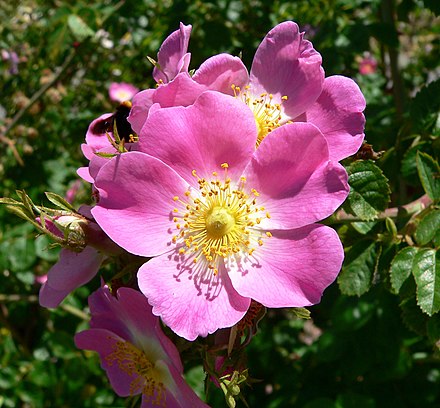
A rose is
a woody perennial flowering
plant of the genus Rosa,
in the family Rosaceae, or the flower it
bears.There are over three hundred species and tens
of thousands of cultivars. They
form a group of plants that
can be erect shrubs, climbing, or trailing, with stems that are often armed with sharp prickles.Roses
are best known as ornamental plants grown
for their flowers in the garden and sometimes indoors. They have been also used for commercial perfumery and commercial cut flower crops. Some are used as landscape plants, for hedging and for other utilitarian purposes such as game cover and slope stabilization. |
Fennel
https://en.wikipedia.org/wiki/Fennel
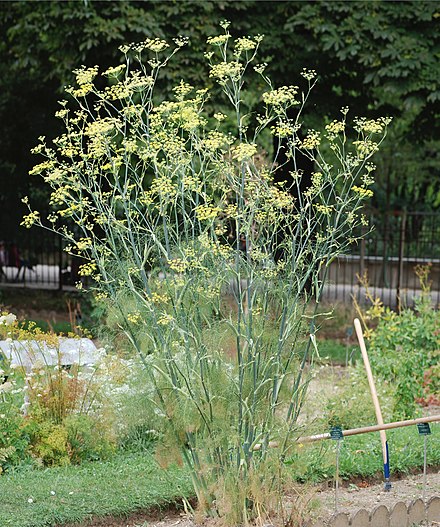
Fennel (Foeniculum
vulgare) is a flowering plant species in
the carrot family. It
is a hardy, perennial herb with
yellow flowers and
feathery leaves. It is indigenous to the shores of the Mediterranean but
has become widely naturalized in many parts of the world, especially on dry soils near the sea-coast and on riverbanks.The aromatic character of fennel fruits derives from volatile
oils imparting mixed aromas, including trans-anethole and estragole (resembling
liquorice), fenchone (mint and camphor), limonene, 1-octen-3-ol (mushroom). Other phytochemicals found
in fennel fruits include polyphenols, such as rosmarinic
acid and luteolin, among others in minor content. |
Fenugreek
https://en.wikipedia.org/wiki/Fenugreek

Fenugreek (; Trigonella
foenum-graecum) is an annual plant in the family Fabaceae, with leaves consisting of three small obovate
to oblong leaflets. It is
cultivated worldwide as a semiarid crop. Its seeds and leaves are common ingredients in dishes from the Indian subcontinent. Also used in traditional
medicine, fenugreek can increase the risk for serious medical side effects,
though its culinary use (in smaller quantities) is usually believed to be safeFenugreek is used as a herb (dried
or fresh leaves), spice (seeds),
and vegetable (fresh leaves, sprouts,
and microgreens). Sotolon is
the chemical responsible for the distinctive maple syrup smell
of fenugreek. |
Fractionated Coconut
https://en.wikipedia.org/wiki/Coconut_oil

Coconut oil, or copra
oil, is an edible oil extracted
from the kernel or meat of mature coconuts harvested
from the coconut palm (Cocos nucifera). It has various applications. Because of its high saturated
fat content, it is slow to
oxidize and, thus, resistant to rancidification,
lasting up to six months at 24 °C (75 °F) without spoiling.Coconut oil has a long history in Asia, particularly in tropical regions where the plant is abundant, where it has been used for cooking. It is the oil of choice in Sri
Lankan cuisine, where it is used for sautéing and frying, in both savoury and sweet dishes. It also plays a prominent role in the cuisines of Thailand and Kerala.Coconut
oil has been used for hair grooming, and has been found to reduce protein loss in hair. |
Garlic
https://en.wikipedia.org/wiki/Garlic

Garlic (Allium sativum) is a species in the onion genus, Allium. Its close relatives include the onion, shallot,
leek, chive, and Chinese onion. It is native to Central Asia and northeastern Iran and has long been a common seasoning worldwide, with a history of several thousand years of human consumption and use.A 2016 meta-analysis of case-control and cohort
studies found a moderate
inverse association between garlic intake and some cancers of the upper digestive tract.Another
meta-analysis found decreased rates of stomach cancer associated
with garlic intake, but cited confounding factors as limitations for interpreting these studies. Further
meta-analyses found similar results on the incidence of stomach cancer by consuming allium vegetables
including garlic. A 2014
meta-analysis of observational epidemiological studies
found that garlic consumption was associated with a lower risk of stomach cancer in Korean people.
|
Grape Seed
https://en.wikipedia.org/wiki/Grape#Seed_constituents

A grape is a fruit, botanically a berry, of the deciduous woody vines of the flowering plant genus Vitis.
Grapes can be eaten fresh as table grapes or they can be used for making wine, jam, grape juice, jelly, grape
seed extract, raisins, vinegar, and grape seed oil. Grapes are a non-climacteric type of fruit, generally occurring in clusters.
Winemaking from red and white grape flesh and skins produces substantial quantities of organic residues, collectively called pomace (also
"marc"), which includes crushed skins, seeds, stems, and leaves generally used as compost. Grape
pomace – some 10-30% of the total mass of grapes crushed – contains various phytochemicals, such as unfermented sugars, alcohol, polyphenols, tannins, anthocyanins,
and numerous other compounds, some of which are harvested and extracted for
commercial applications (a process sometimes called "valorization" of the pomace).
|
Groundnut
https://en.wikipedia.org/wiki/Groundnut

Seeds that ripen underground, of the following plants, all in the Faboideae subfamily
of the legumes:
|
Hazelnut
https://en.wikipedia.org/wiki/Hazelnut

The hazelnut is
the nut of
the hazel and
therefore includes any of the nuts deriving from species of the genus Corylus, especially the nuts of the species Corylus
avellana. It also is known as cobnut or filbert
nut according to species.
Hazelnuts contain particularly high amounts of protein, dietary fiber, vitamin E, iron, thiamin, phosphorus, manganese,
and magnesium, all exceeding 30% DV (table). Several B vitamins have appreciable content. In lesser, but still significant amounts (moderate content, 10-19% DV), are vitamin K, calcium, zinc, and potassium (table).
Hazelnuts are a significant source of total fat, accounting for 93% DV in a 100-gram amount. The fat components are monounsaturated fat as oleic acid (75% of total), polyunsaturated fat mainly as linoleic
acid (13% of total), and saturated fat, mainly as palmitic acid and stearic acid (together, 7% of total).
|
Lemongrass
https://en.wikipedia.org/wiki/Cymbopogon

Cymbopogon, also known as lemongrass, barbed
wire grass, silky
heads, Cochin
grass, Malabar
grass, oily
heads or fever
grass, is a genus of Asian, African, Australian,
and tropical island plants in the grass family.Some
species (particularly Cymbopogon citratus) are commonly cultivated as culinary and medicinal herbs because of their scent, resembling that of lemons (Citrus
limon). Citronella
grass (Cymbopogon nardus and Cymbopogon
winterianus) grow to about 2 m (6.6 ft) and have magenta-colored base stems. These species are used for the production of citronella oil, which is used in soaps, as an insect
repellent (especially mosquitoes) in insect sprays and candles, and in aromatherapy. The principal chemical constituents of citronella, geraniol and citronellol,
are antiseptics, hence their use in household disinfectants and soaps. Besides oil production, citronella grass is also used for culinary purposes, as a flavoring. |
Linseed
https://en.wikipedia.org/wiki/Flax

Flax (Linum
usitatissimum), also known as common flax or linseed, is
a member of the genus Linum in
the family Linaceae. It is a food and fiber crop cultivated in cooler regions of the world. Textiles made from flax are known in Western countries as linen,
and are traditionally used for bed sheets, underclothes, and table linen. Its oil is known as linseed oil.
In addition to referring to the plant itself, the word "flax" may refer to the unspun fibers of the flax plant. The plant species is known only as a cultivated plant, and
appears to have been domesticated just once from the wild species Linum bienne,
called pale flax.In a 100-gram serving, flaxseed contains high levels (> 19% of the Daily Value, DV) of protein, dietary
fiber, several B vitamins, and dietary
minerals.Ten grams of flaxseed contains one gram of water-soluble fiber (which lowers blood cholesterol) and three grams of insoluble fiber (which helps prevent constipation). Flax contains hundreds of times more lignans than
other plant foods.Flaxseeds are especially rich in thiamine, magnesium, potassium,
and phosphorus (DVs above 90%). |
Macadamia
https://en.wikipedia.org/wiki/Macadamia

Macadamia is
a genus of
four species of
trees indigenous to Australia, and constituting part of the plant family Proteaceae. They
are native to north eastern New South Wales and
central and south eastern Queensland. Three species of the genus are
commercially important for their fruit, the macadamia nut (or
simply macadamia), with a total global production of 160,000 tonnes (180,000
short tons) in 2015.
In a 100-gram amount, macadamia nuts provide 740 Calories and are a rich source (20% or more of the Daily Value, DV) of numerous essential nutrients, including thiamine (104% DV), vitamin
B6 (21% DV), manganese (195% DV), iron (28% DV), magnesium (37% DV), and phosphorus (27% DV) (table). Macadamia nuts are 76% fat,
14% carbohydrates, including 9% dietary fiber, and 8% protein (table).
Compared with other common edible nuts, such as almonds and cashews, macadamias are high in total fat and relatively low in protein (table). They have a high amount of monounsaturated fats (59% of total content, table) and contain, as 17% of total fat, the monounsaturated
fat, omega-7 palmitoleic acid.
|
Neem
https://en.wikipedia.org/wiki/Azadirachta_indica

Azadirachta indica, commonly known as neem, nimtree or Indian
lilac,[3] is
a tree in the mahogany family Meliaceae.
It is one of two species in the genus Azadirachta, and is native to the Indian
subcontinent. It is typically grown in tropical and
semi-tropical regions. Neem trees also grow in islands located in the southern part of Iran. Its fruits and seeds are the source of neem
oil.
Ayurveda was the first to bring the anthelmintic, antifungal, antibacterial, and antiviral constituents
of the neem tree to the attention of natural products chemists. The process of extracting neem oil involves extracting the water-insoluble components with ether, petrol ether, ethyl
acetate, and dilute alcohol. The provisional naming was nimbin (sulphur-free crystalline product with melting point at 205 °C, empirical composition
C7H10O2), nimbinin (with similar principle, melting at 192 °C), and nimbidin (cream-coloured containing amorphous sulphur, melting at 90–100 °C). Siddiqui identified nimbidin as the main active antibacterial ingredient, and the highest yielding bitter component in the neem oil.These compounds are stable and found in
substantial quantities in the neem. They also serve as natural insecticides.
Neem-coated urea is being used an alternate to plain urea fertilizer in India. It reduces pollution, improves fertilizer's efficacy and soil health.
|
Nutmeg
https://en.wikipedia.org/wiki/Nutmeg
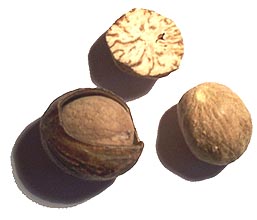
Nutmeg is
the seed or
ground spice of
several species of the genus Myristica. Myristica
fragrans (fragrant
nutmeg or true
nutmeg) is a dark-leaved evergreen tree
cultivated for two spices derived
from its fruit: nutmeg, from its seed, and mace, from the seed covering. It is also a
commercial source of an essential oil and
nutmeg butter.
The essential oil obtained by steam distillation of ground nutmeg is used in the perfumery and pharmaceutical industries. The volatile fraction contains dozens of terpenes and phenylpropanoids,
including d-pinene, limonene, d-borneol, l-terpineol, geraniol, safrol, and myristicin.In
its pure form, myristicin is a toxin, and consumption of excessive amounts of nutmeg can result in myristicin poisoning.
The oil is colorless or light yellow, and smells and tastes of nutmeg. It is used as a natural food flavoring in baked goods, syrups, beverages, and sweets. It is used to replace ground nutmeg, as it leaves no particles in the food. The essential oil is also used in the manufacturing of toothpaste and cough syrups.
|
Olive
https://en.wikipedia.org/wiki/Olive
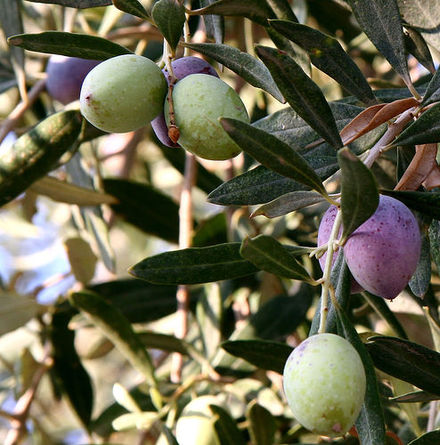
One hundred grams of cured green olives provide 146 calories, are a rich source of vitamin E (25% of the Daily Value, DV), and contain a large amount of sodium (104% DV); other nutrients are insignificant. Green olives are 75% water, 15% fat,
4% carbohydrates and 1% protein (table).
The polyphenol composition of olive fruits varies during fruit ripening and during processing by fermentation when olives are immersed whole in brine or crushed to produce oil
Olive fruit contains several types of polyphenols, mainly tyrosols, phenolic acids, flavonols and flavones, and for black olives, anthocyanins.
The main bitter flavor of olives before curing results from oleuropein and its aglycone which total in content, respectively, 72 and 82 mg/100 g in black olives, and 56 and 59 mg/100 g in green olives.
During the crushing, kneading and extraction of olive fruit to obtain olive oil, oleuropein, demethyloleuropein and ligstroside are hydrolyzed by endogenous beta-glucosidases to form aldehydic aglycones.
|
Peach Kernel
https://en.wikipedia.org/wiki/Peach
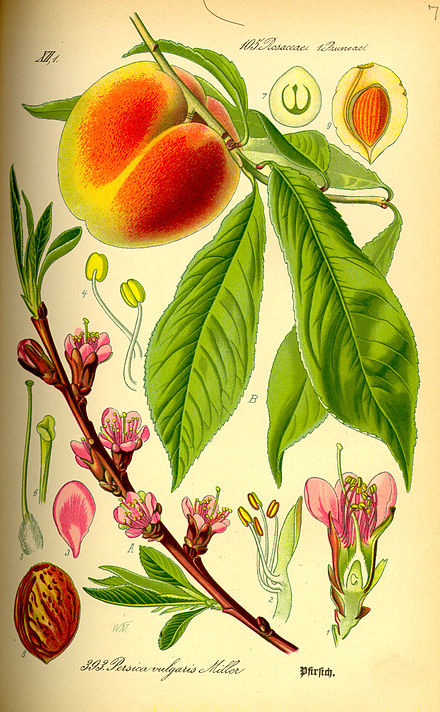
|
Peanut
https://en.wikipedia.org/wiki/Peanut
![]()
Total polyphenols in mg per 100 g of fresh weight were 14–102 in white-flesh nectarines, 18–54 in yellow-flesh nectarines, 28–111 in white-flesh peaches, and 21–61 mg per 100 g in yellow-flesh peaches. The major phenolic compounds identified in peach are chlorogenic acid, catechins and epicatechins, with
other compounds, identified by HPLC, including gallic acid and ellagic acid. Rutin and isoquercetin are
the primary flavonols found in clingstone peaches.
Red-fleshed peaches are rich in anthocyanins, particularly cyanidin glucosides in six peach and six nectarine cultivars and malvin glycosides in clingstone peaches. As with many other members of the rose
family, peach seeds contain cyanogenic glycosides, including amygdalin (note the subgenus designation: Amygdalus). These substances are capable of decomposing into a sugar molecule and hydrogen cyanide gas.
Some 110 chemical compounds contribute to peach aroma, including alcohols, ketones, aldehydes, esters, polyphenols and terpenoids. |
Peppermint
https://en.wikipedia.org/wiki/Peppermint
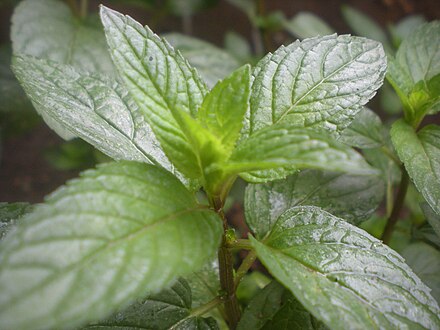
Peppermint (Mentha × piperita, also known as Mentha balsamea Wild) is a hybrid mint, a cross between watermint and spearmint. Indigenous
to Europe and the Middle East, the plant is now widely spread and cultivated in many regions of the world. It is occasionally found in the wild with its parent species.
Although the genus Mentha comprises more than 25 species, the one in most common use is peppermint.
Peppermint has a high menthol content. The oil also contains menthone and carboxyl esters, particularly menthyl acetate. Dried peppermint typically has 0.3–0.4% of volatile oil containing menthol (7–48%), menthone (20–46%), menthyl acetate (3–10%), menthofuran (1–17%)
and 1,8-cineol (3–6%). Peppermint oil also contains small amounts of many additional compounds including limonene, pulegone, caryophyllene and pinene.
Peppermint contains terpenoids and flavonoids such as eriocitrin, hesperidin, and kaempferol 7-O-rutinoside.
|
Rosehip
https://en.wikipedia.org/wiki/Rose_hip
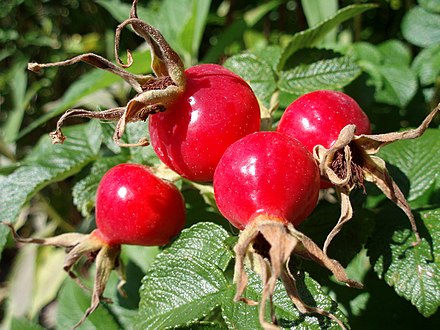
The rose hip or rosehip,
also called rose haw and rose
hep, is the accessory fruit of
the rose plant.
Wild rose hip fruits are particularly rich in vitamin C, containing 426 mg per 100 g or 0.4% by weight (w/w). However, RP-HPLC assays of fresh rose hips and several commercially available products revealed a wide range of L-ascorbic acid (vitamin C) content, ranging from 0.03 to 1.3%.
Rose hips contain the carotenoids beta-carotene, lutein, zeaxanthin and lycopene, which are under basic
research for a variety of potential biological roles. A meta-analysis of human studies examining the potential for rose hip extracts to reduce arthritis pain concluded there was a small effect requiring further analysis of safety and efficacy in clinical trials. Use
of rose hips is not considered an effective treatment for knee osteoarthritis.
|
Rosemary
https://en.wikipedia.org/wiki/Rosemary

Salvia rosmarinus, commonly known as rosemary,
is a woody, perennial herb with
fragrant, evergreen, needle-like leaves and white, pink, purple, or blue flowers, native to
the Mediterranean region.Rosemary
contains a number of phytochemicals, including rosmarinic
acid, camphor, caffeic
acid, ursolic acid, betulinic
acid, carnosic acid, and carnosol.Rosemary
essential oil contains 10–20% camphor.
Rosemary leaves are used as a flavoring in foods, such as stuffing and roast lamb, pork, chicken, and turkey. Fresh or dried leaves are used in traditional Mediterranean cuisine. They have a bitter, astringent taste and a characteristic aroma which complements many cooked foods. Herbal tea can
be made from the leaves. When roasted with meats or vegetables, the leaves impart a mustard-like aroma with an additional fragrance of charred wood that goes well with barbecued foods.
In amounts typically used to flavor foods, such as one teaspoon (1 gram), rosemary provides no nutritional value. Rosemary extract has been shown to improve the shelf life and heat stability of omega
3–rich oils which are prone to rancidity.
|
Safflower
https://en.wikipedia.org/wiki/Safflower

Safflower, Carthamus
tinctorius, is a highly branched, herbaceous, thistle-like annual
plant. It is commercially cultivated for vegetable oil extracted
from the seeds and
was used by the early Spanish colonies along the Rio Grande as
a substitute for saffron.Traditionally,
the crop was grown for its seeds, and used for coloring and flavoring foods, in medicines, and making red (carthamin) and yellow dyes, especially before cheaper aniline dyes became
available.For the last fifty years or so, the plant has been cultivated mainly for the vegetable oil extracted from its seeds. Safflower seed oil is flavorless and colorless, and nutritionally similar
to sunflower oil. It is used mainly in cosmetics and as a cooking
oil, in salad dressing, and for the production of margarine. INCI nomenclature
is Carthamus tinctorius. |
Salmon
https://en.wikipedia.org/wiki/Salmon

Salmon is
the common name for several species of ray-finned fish in
the family Salmonidae.
Other fish in the same family include trout, char, grayling,
and whitefish.Salmon
is a popular food. Classified as an oily fish, salmon is considered to be healthy due to the fish's high protein,
high omega-3 fatty acids, and high vitamin
D content. Salmon is also a source of cholesterol, with a range of 23–214 mg/100 g depending
on the species. |
Sesame
https://en.wikipedia.org/wiki/Sesame

Sesame ( or ; Sesamum
indicum) is a flowering plant in
the genus Sesamum, also called benne.[2] Numerous
wild relatives occur in Africa and a smaller number in India. It is widely naturalized in
tropical regions around the world and is cultivated for its edible seeds, which grow in pods. World production in 2016 was 6.1 million tonnes, with Tanzania, Myanmar, India,
and Sudan as
the largest producers.
A meta-analysis showed that sesame consumption produced small reductions in both systolic and diastolic blood pressure. Sesame oil studies reported a
reduction of oxidative stress markers and lipid peroxidation.
Sesame seeds contain the lignans sesamolin, sesamin, pinoresinol, and lariciresinol.
|
Spearmint
https://en.wikipedia.org/wiki/Spearmint

Spearmint, also known as garden
mint, common
mint, lamb
mint and mackerel
mint, is
a species of mint, Mentha
spicata, native to Europe and southern temperate Asia, extending from Ireland in the west to southern China in the east. It is naturalized in many other temperate parts of the world, including northern and southern Africa, North
America and South
America. It
is used as a flavouring in food and herbal teas. The aromatic oil, called oil of spearmint, is also used as a flavouring and sometimes as a scent. tea.
Grown in the mountainous regions of Morocco, this variety of mint possesses a clear, pungent, but mild aroma. Spearmint is an ingredient in several mixed drinks, such as the mojito and mint
julep. Sweet
tea, iced and flavoured with spearmint |
Soyabean
https://en.wikipedia.org/wiki/Soybean
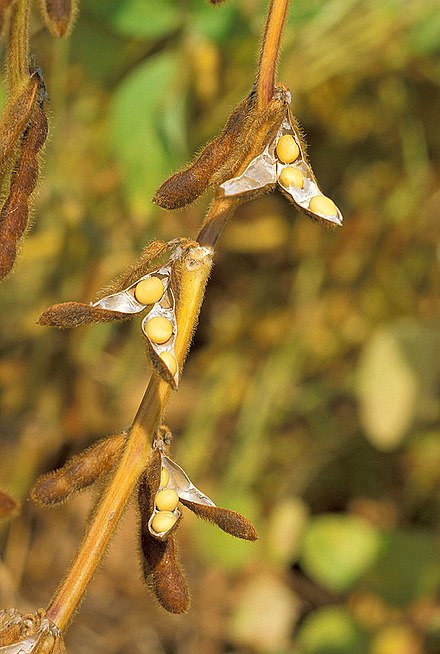
The soybean or soya
bean (Glycine
max) is
a species of legume native
to East Asia, widely grown for its edible bean,
which has numerous uses.Soybeans are an exceptional source of essential nutrients, providing in a 100 gram serving (raw, for reference) high contents of the Daily
Value (DV) especially for protein (36% DV), dietary fiber (37%), iron (121%), manganese (120%), phosphorus (101%)
and several B vitamins, including folate (94%)
(table). High contents also exist for vitamin K, magnesium, zinc and potassium (table). |
Squalene
https://en.wikipedia.org/wiki/Squalene

Squalene is a natural organic compound originally obtained for commercial purposes primarily from shark liver oil (hence its name, as Squalus is a genus of sharks). All plants and animals produce squalene as a biochemical intermediate, including humans.
It occurs in high concentrations in the stomach oil of birds in the order Procellariiformes.
Squalene is a hydrocarbon and a triterpene, and is a precursor for synthesis of all plant and animal sterols, including cholesterol and steroid
hormones in the human body.s a common lipid produced
by sebaceous glands,
squalene has a role in topical skin
lubrication and protection. Toxicology studies
indicate that in the concentrations used in cosmetics,
squalene has low acute toxicity, and is not a significant contact allergen or irritant.Immunologic
adjuvants are
substances, administered in conjunction with a vaccine,
that stimulate the immune system and
increase the response to the vaccine. Squalene is not itself an adjuvant, but it has been used in conjunction with surfactants in
certain adjuvant formulations.
|
Tea Tree
https://en.wikipedia.org/wiki/Tea_tree

Camellia sinensis is a species of evergreen shrubs or small trees in the flowering plant family Theaceae whose
leaves and leaf buds are used to produce tea. Common names include "tea plant", "tea shrub", and "tea tree" (not to be confused with Melaleuca alternifolia, the source of tea tree oil, or Leptospermum scoparium, the New Zealand tea tree).
C. sinensis var. sinensis and C. s. var. assamica are two major varieties grown today White tea, yellow tea, green tea, oolong, dark
tea (which includes pu-erh tea) and black tea are all harvested from one or the other, but are processed differently to attain varying levels of oxidation. Kukicha (twig tea)
is also harvested from C. sinensis, but uses twigs and stems rather than leaves.
|
Turpantine
https://en.wikipedia.org/wiki/Turpentine

Turpentine (which is also called spirit of turpentine, oil of turpentine, wood turpentine, terebenthene, terebinthine and (colloquially), turps) is a fluid obtained by the distillation of resin harvested from living trees, mainly pines.
It is mainly used as a solvent, and as a source of material for organic syntheses.
Turpentine is composed of terpenes, primarily the monoterpenes alpha- and beta-pinene, with lesser amounts of carene, camphene, dipentene,
and terpinolene.
|
Thyme
https://en.wikipedia.org/wiki/Thyme
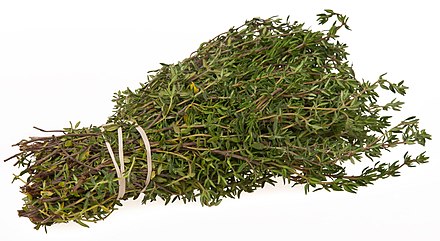
Thyme ()
is the herb (dried aerial parts) of some members of the genus Thymus of
aromatic perennial evergreen herbs in the mint family Lamiaceae. Thymes are relatives of the oregano genus Origanum.
They have culinary, medicinal, and ornamental uses, and the species most commonly cultivated and used for culinary purposes is Thymus vulgaris.Oil
of thyme, the essential oil of
common thyme (Thymus vulgaris), contains 20–54% thymol. Thyme
essential oil also contains a range of additional compounds, such as p-cymene, myrcene, borneol,
and linalool. Thymol,
an antiseptic, is an active ingredient in various commercially produced mouthwashes such
as Listerine.[ Before
the advent of modern antibiotics, oil of thyme was used to medicate bandages. |
Turpentine
https://en.wikipedia.org/wiki/Turpentine

urpentine (which is also called spirit of turpentine, oil of turpentine, wood turpentine, terebenthene, terebinthine and (colloquially), turps) is a fluid obtained by the distillation of resin harvested from living trees, mainly pines.
It is mainly used as a solvent, and as a source of material for organic syntheses.
Turpentine is composed of terpenes, primarily the monoterpenes alpha- and beta-pinene, with lesser amounts of carene, camphene, dipentene,
and terpinolene.
Mineral turpentine or other petroleum distillates
are used to replace[ turpentine
– although their chemistries are very different. |
Wheatgerm
https://en.wikipedia.org/wiki/Cereal_germ#Wheat_germ

Wheat germ or wheatgerm is a concentrated source of several essential nutrients, including vitamin E, folate (folic acid), phosphorus, thiamin, zinc,
and magnesium, as well as essential fatty acids and fatty alcohols. It is a good source of fiber. White bread is made using flour that
has had the germ and bran removed. Wheat germ can be added to protein shakes, casseroles, muffins, pancakes, cereals, yogurt,
smoothies, cookies, and other goods.Wheat germ can become rancid if not properly stored in a refrigerator or freezer and away from sunlight. Some manufacturers prevent rancidity by storing wheat germ in vacuum-sealed glass containers, or by placing an oxygen-absorbing sachet inside air-tight packaging.
|
| Organic Herbs |
Amla (Emblica Officinalis)
https://en.wikipedia.org/wiki/Phyllanthus_emblica

Phyllanthus emblica, also known as emblic, emblic myrobalan, myrobalan,[Indian gooseberry, Malacca tree, or amla from Sanskrit amalaki is a deciduous tree of the family
Phyllanthaceae. It has edible fruit, referred to by the same name. These fruits are reputed to contain high amounts of ascorbic acid (vitamin C), and have bitter taste that may derive from a high density of ellagitannins, such as emblicanin A (37%), emblicanin B (33%), punigluconin (12%), and pedunculagin (14%). Amla also contains
punicafolin and phyllanemblinin A, phyllanemblin other polyphenols, such as flavonoids, kaempferol, ellagic acid, and gallic acid |
Arjuna Bark
https://en.wikipedia.org/wiki/Terminalia_arjuna

Terminalia arjuna is
a tree of the genus Terminalia.
It is commonly known as arjuna or arjun
tree in English, thella
maddi in Telugu, kumbuk in
Sinhala, marudha maram in
Tamil and neer maruthu (നീർമരുത്) in
Malayalam. Hole Matthi in
Kannada.The arjuna is one of the species whose leaves are fed on by the Antheraea paphia moth which produces the tassar
silk, a wild silk of commercial importance.The Arjuna plant (lat. Terminalia arjuna) has traditionally been used to treat heart disease for centuries, which is why it got the nickname “Guardian of the heart.”In Theravada
Buddhism, Arjuna is said to have been used as the tree for achieved enlightenment, or Bodhi by the tenth Buddha (title) called "Anomadassi
Buddha". |
Ashwagandha Root
https://en.wikipedia.org/wiki/Withania_somnifera

Withania somnifera, known commonly as ashwagandha, Indian
ginseng poison gooseberry, or winter
cherry, is
a plant in the Solanaceae or
nightshade family. Several other species in the genus Withania are
morphologically similar.The main phytochemical constituents are withanolides –
which are triterpene lactones –
withanolides, withaferin A, alkaloids, steroidal lactones, tropine,
and cuscohygrine. Some 40 withanolides, 12 alkaloids, and numerous sitoindosides have been isolated. Withanolides are structurally similar to the ginsenosides of Panax
ginseng, leading to a common name for W. somnifera, "Indian ginseng".The plant, particularly its root powder, has been used for centuries in traditional
Indian medicine. Mainly due to the poor quality of clinical research, there is no high-quality
evidence that it provides any medicinal benefit and may cause adverse effects if taken together with prescription
drugs. Dietary supplements containing ashwagandha are marketed in the U.S., but there is no evidence they have any effect. |
Bahera
https://en.wikipedia.org/wiki/Terminalia_bellirica
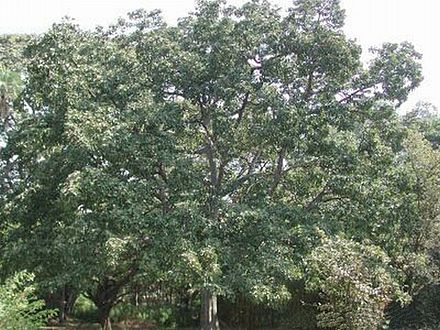
Terminalia bellirica, known as bahera or beleric or bastard
myrobalan, (Arabic: beliledj بليلج, Sanskrit:
Bibhitaka Aksha), is
a large deciduous tree common on plains and lower hills in Southeast Asia, where it is also grown as an avenue tree.
In the Charaka Samhita, the ancient Ayurvedic text, Bibhitaki fruits are mentioned as having qualities to alleviate disease, and bestow longevity, intellectual prowess and strength. There are several "rasaayan" described in the Charaka Samhita, that use Bibhitaki.
Description of Fourth Amalaka Rasaayan, which includes Bibhitaki as one of the fruits:
By this treatment, the sages regained youthfulness and attained disease-free life of many hundred years, and endowed with the strength of physique, intellect and senses, practiced penance with utmost devotion.
This kernels are eaten by the Lodha people of the Indian subcontinent for their mind-altering qualities.
|
Cinnamon
https://en.wikipedia.org/wiki/Cinnamon

Cinnamon is
a spice obtained
from the inner bark of several tree species from the genus Cinnamomum. Cinnamon is used mainly as an aromatic condiment and
flavouring additive in a wide variety of cuisines, sweet and savoury dishes, breakfast
cereals, snackfoods, tea and traditional
foods. The aroma and flavour of cinnamon derive from its essential oil and
principal component, cinnamaldehyde, as well as numerous other constituents including eugenol.Reviews
of clinical trials reported lowering of fasting plasma glucose and
inconsistent effects on hemoglobin A1C (HbA1c, an indicator of chronically elevated plasma glucose). Four of the reviews reported a decrease in fasting plasma glucose, only two reported lower HbA1c, and one reported no change to either measure. |
Coriander
https://en.wikipedia.org/wiki/Coriander

Coriander (;[1] Coriandrum
sativum) is an annual herb in
the family Apiaceae. It is also known as Chinese parsley, dhania or cilantro (). All
parts of the plant are edible, but the fresh leaves and the dried seeds (as a spice)
are the parts most traditionally used in cooking.Raw coriander leaves are 92% water, 4% carbohydrates, 2% protein,
and less than 1% fat (table). The nutritional profile of coriander seeds is different from the fresh stems or leaves. In a 100 gram reference amount, leaves are particularly rich in vitamin
A, vitamin C and vitamin
K, with moderate content of dietary minerals (table). Although seeds generally have lower content of vitamins, they do provide significant amounts of dietary
fiber, calcium, selenium, iron, magnesium and manganese. |
Fennel
https://en.wikipedia.org/wiki/Fennel

Fennel (Foeniculum vulgare) is a flowering plant species in the carrot family. It is a hardy, perennial herb with
yellow flowers and feathery leaves. It is indigenous to the shores of the Mediterranean but has become widely naturalized in many parts of the world, especially on dry soils near the sea-coast and on riverbanks.
It is a highly aromatic and flavorful herb used in cookery and, along with the similar-tasting anise, is one of the primary ingredients of absinthe.A
100-gram reference amount of fennel fruits provides 1,440 kilojoules (345 kilocalories) of food energy, and is a rich source (20% or more of the Daily Value,
DV) of protein, dietary
fiber, B
vitamins and
several dietary minerals,
especially calcium, iron, magnesium and manganese,
all of which exceed 100% DV (table). Fennel fruits are 52% carbohydrates (including
40% dietary fiber), 15% fat,
16% protein and 9% water (table).
|
Fenugreek
https://en.wikipedia.org/wiki/Fenugreek

Fenugreek (; Trigonella
foenum-graecum) is an annual plant in the family Fabaceae, with leaves consisting of three small obovate
to oblong leaflets.Fenugreek dietary
supplements are manufactured from powdered seeds into capsules, loose powders, teas, and liquid extracts in
many countries. Powders may also be used as a topical medication or dressing for skin wounds or eczema.
Fenugreek is sometimes used as animal feed. It provides a green fodder palatable to ruminants. The seeds are also used to feed fish, domestic rabbits and ruminants.
Fenugreek seeds and leaves contain the molecule sotolone, which imparts the aroma of fenugreek and curry in high concentrations, and maple syrup or caramel in lower concentrations. Fenugreek is used as a flavoring agent in imitation maple syrup or tea, and as a dietary
supplement.
A mysterious odor of maple syrup – the maple syrup event occurring in New York City in 2005 – was eventually traced to a nearby New Jersey factory of a food additives company processing fenugreek seeds.
|
Giloy Root
https://en.wikipedia.org/wiki/Tinospora_cordifolia

Tinospora cordifolia, which is known by the common names gurjo, heart-leaved
moonseed, guduchi,
and giloy,, is an herbaceous vine of
the family Menispermaceae indigenous
to tropical regions of the Indian subcontinent.Tinospora contains
diverse phytochemicals, including alkaloids, phytosterols, glycosides,
and mixed other chemical compounds. Columbin, tinosporaside, jatrorhizine, palmatine, berberine, tembeterine, tinocordifolioside, phenylpropene disaccharides, choline, tinosporic
acid, tinosporal, tinosporon,
and tinosporide have been isolated from Tinospora cordifolia. |
Ginger Root
https://en.wikipedia.org/wiki/Ginger

Ginger (Zingiber
officinale) is a flowering plant whose rhizome, ginger
root or ginger, is widely
used as a spice and
a folk medicine.
The characteristic fragrance and flavor of ginger result from volatile oils that compose 1-3% of the weight of fresh ginger, primarily consisting of zingerone, shogaols, and gingerols with
[6]-gingerol (1-[4'-hydroxy-3'-methoxyphenyl]-5-hydroxy-3-decanone) as the major pungent compound. Zingerone is produced from gingerols during drying, having lower pungency and a spicy-sweet aroma. Shogaols are more pungent and have higher antioxidant activity but not found in raw ginger, but is formed from gingerols during heating, storage or via acidity.
Fresh ginger also contains an enzyme zingibain which is a cysteine protease and has similar properties to rennet.
|
Gokhru
..

Gokshura churna is a traditional herbal formulation that aims at both revitalising and rejuvenating the body. The host of anti-inflammatory and diuretic properties of this formulation makes it extremely beneficial for improving kidney functions and treating a number of genitourinary problems like urinary
tract infection, urinary distension, urinary calculi, dysuria, difficulty in micturition, treating osteoarthritis, gout and relieving from sexual problems. |
Gotukola
https://en.wikipedia.org/wiki/Centella_asiatica

In Burmese
cuisine, raw pennywort is used as the main constituent in a salad mixed with onions, crushed peanuts, bean powder and seasoned with lime juice and fish sauce. Centella is used as a leafy green in Sri Lankan cuisine,
being the predominantly locally available leafy green, where it is called gotu kola.In traditional
medicine, C.
asiatica has been used to treat various disorders and minor wounds.In the context of phytoremediation, C.
asiatica is a potential phytoextraction tool owing to its ability to take up and translocate metals
from root to shoot when grown in soils contaminated by heavy metals. |
Harad
https://www.1mg.com/ayurveda/harad-52

Harad is an herb which is commonly known as Harade in India and has multiple Ayurvedic health benefits.
Harad is an amazing herb that can be helpful in controlling hair loss and promoting hair growth. This is due to the presence of vitamin C, iron, manganese, selenium and copper that provides optimal nourishment to the scalp. The oil obtained from Harad seeds is used to improve the motility of the gastrointestinal tract. This helps promote bowel movement and promote easy removal of stool in case of chronic constipation. Taking Harad powder (mixed
with water) two times a day helps boost the immune system by reducing the cell damage due to its antioxidant and immunomodulatory activities.
Applying Harad powder along with coconut oil in the form of paste is used to heal wounds due to its astringent property. It also helps fight against infectious agents and prevents skin infections. Harad extract can also be applied on the eyelids to manage certain eye diseases as it acts as a nerve tonic. |
Henna Leaves
https://en.wikipedia.org/wiki/Bay_leaf

The bay leaf is
an aromatic leaf commonly used in cooking. It can be used whole, or as dried and groundThe leaves contain about 1.3% essential oils (ol. lauri folii), consisting of 45% eucalyptol, 12% other terpenes,
8-12% terpinyl acetate, 3–4% sesquiterpenes, 3% methyleugenol,
and other α- and β-pinenes, phellandrene, linalool, geraniol, terpineol,
and contain lauric acid also.In Indian cuisine, bay laurel leaves are sometimes used in place of Indian
bay leaf, although they have a different flavour. They are most often used in rice dishes like biryani and as an ingredient in garam
masala. Bay (laurel) leaves are frequently packaged as tezpattā , the Hindi term for Indian bay leaf), creating confusion between the two herbs.. |
Kutki Root
https://www.herbalreality.com/herb/kutki/

Picrorhiza kurroa is
one of the major income generating non-timber forest products found in the Nepalese Himalayas. It is one of the oldest medicinal plants traded from the Karnali
zone. Known as kutki in
Nepali, it is a perennial herb and is used as a substitute for Indian gentian (Gentiana
kurroo).The rhizome has
a long history of use in Indian Ayurvedic medicine for the treatment of digestive problems. Other uses have been proposed (e.g. for asthma, liver damage, wound healing, vitiligo) but the medical evidence is not yet conclusive. It appears to be relatively safe based on its long history of traditional use. Kutki has hepato-protective properties and thus supports the liver and spleen. It is used in all forms of liver damage, cirrhosis and inflammation of the liver. It
protects the liver against damage from the hepatitis C virus.Kutki is a very bitter root that has wonderful anti-inflammatory and anti-bacterial properties. It grows in the freezing climate of the Himalayas and evidently absorbs some of this ‘cooling’ property from its surrounding environment. Katuka literally means ‘pungent’ which is strange as it is a very bitter tasting herb. |
Manjistha Root
https://en.wikipedia.org/wiki/Rubia_cordifolia

ubia cordifolia, often known as common
madder or Indian
madder, is a species of flowering plant in
the coffee family, Rubiaceae.
It has been cultivated for a red pigment derived from roots.Rubia cordifolia was an
economically important source of a red pigment in many regions of Asia, Europe and Africa. It was extensively cultivated from antiquity until the mid nineteenth century. The plant's roots contain an anthraquinone called purpurin (1,2,4-Trihydroxyanthraquinone)
that gives its red colour as a textile dye It was also used as a colourant,
especially for paint, that is referred to as Madder
lake. The substance was also derived other species
The roots of Rubia cordifolia are also the source of a medicine used in Ayurveda; this is commonly known in Ayurvedic Sanskrit as Manjistha (or Manjista or Manjishta) and the commercial product in Hindi as Manjith.
It is known as btsod (Tibetan: བཙོད་) in Traditional
Tibetan Medicine where it is used to treat blood disorders; spread heat (Tibetan: འགྲམས་ཚད་), excess heat in the lungs, kidneys, and intestines; reduce swelling; and is a
component of the three reds (Tibetan: དམར་གསུམ་), a subcompound included in many Tibetan preparations in order to remove excess heat in the blood.
|
Moringa Leaves
https://en.wikipedia.org/wiki/Moringa

Moringa, native to parts of Africa and Asia, is the sole genus in the flowering plant family Moringaceae. The name is derived from murungai, the Tamil word
for drumstick, and the plant is commonly referred to as the drumstick tree. It contains 13 species from tropical and subtropical climates that range in size from tiny herbs to massive trees. Moringa species grow quickly in many types of environments.
The most widely cultivated species is Moringa oleifera, native to the foothills of the Himalayas in northwestern India,[5] a multipurpose
tree cultivated throughout the tropics and marketed as a dietary supplement, health food or source for herbalism practices.[6] The fruit
pods of Moringa oleifera ("drumsticks") are consumed as food in many parts of the world, but particularly in South Asia. The leaves are commonly used to make tea. Oils are made from the seeds, while powders can be made from the leaves and roots.
|
Mukuna Seed
https://en.wikipedia.org/wiki/Mucuna_pruriens

Mucuna pruriens is
a tropical legume native
to Africa and tropical Asia and widely naturalized and cultivated.[2] Its
English common names include monkey
tamarind, velvet
bean, Bengal
velvet bean, Florida
velvet bean, Mauritius
velvet bean, Yokohama
velvet bean, cowage, cowitch, lacuna
bean, and Lyon bean. The
plant is notorious for the extreme itchiness it produces on contact,[3] particularly
with the young foliage and the seed pods. It has agricultural and horticultural value and is used in herbalism.In
many parts of the world Mucuna pruriens is
used as an important forage, fallow and green
manure crop. Since the plant is a legume, it fixes
nitrogen and fertilizes soil. In Indonesia, particularly Java,
the beans are eaten and widely known as 'Benguk'. The beans can also be fermented to form a food similar to tempe and known as Benguk
tempe or 'tempe Benguk'. |
Mulethi Root
https://en.wikipedia.org/wiki/Liquorice

Liquorice (British
English) or licorice (American
English) ( LIK-ər-is(h)) is
the common name of Glycyrrhiza glabra, a flowering plant of
the bean family Fabaceae, from the
root of which a sweet, aromatic flavouring can be extracted.
Liquorice is used as a flavouring in candies and tobacco, particularly in some European and West Asian countries.Liquorice extracts have been used in herbalism and traditional medicine.
The scent of liquorice root comes from a complex and variable combination of compounds, of which anethole is up to 3% of total volatiles. Much of the sweetness in liquorice comes from glycyrrhizin, which has a sweet taste, 30–50 times the sweetness of sugar. The sweetness is very different from sugar, being less instant, tart, and lasting longer.The isoflavene glabrene and the isoflavane glabridin, found in the roots of liquorice, are phytoestrogens.
|
Nagarmotha
https://en.wikipedia.org/wiki/Cyperus_scariosus

Cyperus scariosus, commonly known as cypriol or nutgrass, is a plant of the family Cyperaceae. It is a perennial herbaceous riverbed plant native to India's Madhya Pradesh state. It is one of the most invasive weeds known, having spread out to a world-wide distribution in tropical and temperate regions.
The plant is mentioned in the ancient Ayurvedic medicine text Charaka Samhita, and is used extensively in Chinese medicine and traditional perfuming. Ayurvedic physicians use the plant for medicinal purposes for fevers, digestive system disorders, dysmenorrhea and other maladies. Modern alternative medicine recommends using the plant to treat nausea, fever and inflammation; for pain reduction; for muscle relaxation and for many other disorders.The essential oil from the tuber has a deep, spicy woody-earthy smell, is highly prized in India and is used extensively as a raw ingredient in perfumery, aromatherapy and soap making.Steam
distillation of the tubers of cypriol yields 0.035–0.040% of an essential oil, the principal content of which is cyperene.
Other constituent compounds are alpha-copaene and caryophyllene
oxide.
|
Neem
https://en.wikipedia.org/wiki/Azadirachta_indica

Azadirachta indica, commonly known as neem, nimtree or Indian
lilac, is
a tree in the mahogany family Meliaceae.
It is one of two species in the genus Azadirachta, and is native to the Indian
subcontinent.
Ayurveda was the first to bring the anthelmintic, antifungal, antibacterial, and antiviral constituents
of the neem tree to the attention of natural products chemists. The process of extracting neem oil involves extracting the water-insoluble components with ether, petrol ether, ethyl
acetate, and dilute alcohol. The provisional naming was nimbin (sulphur-free crystalline product with melting point at 205 °C, empirical composition
C7H10O2), nimbinin (with similar principle, melting at 192 °C), and nimbidin (cream-coloured containing amorphous sulphur, melting at 90–100 °C). Siddiqui identified nimbidin as the main active antibacterial ingredient, and the highest yielding bitter component in the neem oil. These
compounds are stable and found in substantial quantities in the neem. They also serve as natural insecticides.
Neem-coated urea is being used an alternate to plain urea fertilizer in India. It reduces pollution, improves fertilizer's efficacy and soil health.
|
Punarnava Root
https://en.wikipedia.org/wiki/Boerhavia_diffusa

Boerhaavia diffusa is
a species of flowering plant in the four o'clock family which
is commonly known as punarnava (meaning
that which rejuvenates or renews the body in Ayurveda), red
spiderling, spreading
hogweed, or tarvine. It
is taken in herbal medicine for
pain relief and other uses. The leaves of Boerhaavia diffusa are
often used as a green vegetable in many parts of India.Boerhaavia G and Boerhavia H are two rotenoids isolated
from B. diffusa.[6] A quinolone alkaloid, lunamarine,
isolated from B. diffusa has shown some in
vitro anticancer, antiestrogenic, immunomodulatory,[ and anti-amoebic activity
(particularly against Entamoeba histolytica).[ The
plant contains a protein called BDP-30, presumably a ribosome-inactivating protein. |
Rose Petals
https://en.wikipedia.org/wiki/Rose

A rose is
a woody perennial flowering
plant of the genus Rosa,
in the family Rosaceae, or the flower it
bears.There are over three hundred species and tens
of thousands of cultivars. They
form a group of plants that
can be erect shrubs, climbing, or trailing, with stems that are often armed with sharp prickles.Roses
are best known as ornamental plants grown
for their flowers in the garden and sometimes indoors. They have been also used for commercial perfumery and commercial cut flower crops. Some are used as landscape plants, for hedging and for other utilitarian purposes such as game cover and slope stabilization. |
Safed Musli Root
https://en.wikipedia.org/wiki/Chlorophytum_borivilianum

Chlorophytum borivilianum is a herb with lanceolate leaves, from tropical wet forests in peninsular India. The Hindi name is safed musli (also commonly known as musli).
It is cultivated and eaten as a leaf vegetable in some parts of India, and its roots are used as a health tonic under the name safed musli.[2] In traditional Indian medicine it is used as 'Rasayan'
or adaptogen.
|
Shatavari Root
https://en.wikipedia.org/wiki/Asparagus_racemosus

Asparagus racemosus (satavar, shatavari,
or shatamull, shatawari)
is a species of asparagus common throughout India and
the Himalayas. It grows 1–2 m (3 ft 3 in–6 ft 7 in) tall and prefers to take root in gravelly, rocky soils high up in piedmont plains,
at 1,300–1,400 m (4,300–4,600 ft) elevation.[2] It
was botanically described in 1799. Because
of its multiple uses, the demand for Asparagus racemosus is
constantly on the rise. Because of destructive harvesting, combined with habitat destruction, and deforestation,
the plant is now considered "endangered" in its natural habitat.Shatavari is important in traditional Ayurvedic medicine. Extracts made from dried roots are used for various reproductive and hormonal issues in women. It is also used in cases of gastric
ulcers and indigestion.
Asparagamine A, a polycyclic alkaloid was isolated from the dried roots and subsequently synthesized to allow for the construction of analogs.
Steroidal saponins, shatavaroside A, shatavaroside B, filiasparoside
C, shatavarins, immunoside, and schidigerasaponin D5 (or asparanin A) were isolated from the roots of Asparagus racemosus.
Also known is the isoflavone 8-methoxy-5,6,4'-trihydroxyisoflavone 7-O-β-D-glucopyranoside.
|
Stevia
https://en.wikipedia.org/wiki/Stevia

Stevia () is
a sweetener and sugar substitute derived from the leaves of the plant species Stevia rebaudiana, native to Brazil and Paraguay.
The active compounds are steviol glycosides (mainly stevioside and rebaudioside), which have 30 to 150 times the sweetness of sugar, are heat-stable, pH-stable, and not fermentable. The body does not metabolize the glycosides in stevia, so it contains zero calories, like some artificial sweeteners. Stevia's taste has a slower onset and longer duration than that of sugar, and some of its extracts may have a bitter or licorice-like aftertaste at high concentrations.
The legal status of stevia as a food additive or dietary supplement varies from country to country.
Glycosides are molecules that contain glucose residues bound to other non-sugar substances called aglycones (molecules with other sugars are polysaccharides). Preliminary experiments deduce that the tongue's taste receptors react to the glycosides and transduce the sweet taste sensation and the lingering bitter aftertaste by direct activation of sweet and bitter receptors.
According to basic research, steviol glycosides and steviol interact with a protein channel called TRPM5, potentiating the signal from the sweet or bitter receptors, amplifying the taste of other sweet, bitter and umami tastants. The synergetic effect of the
glycosides on the sweet receptor and TRPM5 explains the sweetness sensation. Some steviol glycosides (rebaudioside A) are perceived sweeter than others (stevioside).
Steviol cannot be further digested in the digestive tract and is taken up into the bloodstream, metabolised by the liver to steviol glucuronide, and excreted in the urine.
A three-dimensional map of the proteins in stevia, showing the crystalline structures that produce both the sensation of sweetness and bitter aftertaste in the sweetener, was reported in 2019.
|
|